
(doramectin
and levamisole injection)
(5 mg/mL doramectin, 150 mg/mL levamisole hydrochloride)
CAUTION: Federal law restricts this drug to use by or on the order of a licensed veterinarian.
INDICATIONS:
VALCOR™ is indicated for the treatment and control of the following species of parasites in beef cattle two months of age and older and in replacement dairy heifers less than 20 months of age. Not for use in beef bulls intended for breeding over 1 year of age, dairy calves, and veal calves.
Gastrointestinal Roundworms (adults and fourth stage larvae): Ostertagia ostertagi (including inhibited larvae), O. lyrata, Haemonchus placei, Trichostrongylus axei, T. colubriformis, T. longispicularis*, Cooperia oncophora, C. pectinata*, C. punctata, C. surnabada, Bunostomum phlebotomum*, Strongyloides papillosus*, Oesophagostomum radiatum, Trichuris spp.*, Nematodirus helvetianus*. Lungworms (adults and fourth stage larvae): Dictyocaulus viviparus. Eyeworms (adults): Thelazia spp. Grubs (parasitic stages): Hypoderma bovis, H. lineatum. Sucking Lice: Haematopinus eurysternus, Linognathus vituli, Solenopotes capillatus. Mange Mites: Psoroptes bovis, Sarcoptes scabiei. *Adults only WARNINGS AND PRECAUTIONS:
WITHDRAWAL PERIODS AND RESIDUE WARNINGS:
Cattle must not be slaughtered for human consumption within 15 days following last treatment with this drug product. Not for use in female dairy cattle 20 months of age or older, including dry dairy cows; use in these cattle may cause drug residues in milk and/or in calves born to these cows or heifers. Not for use in beef calves less than 2 months of age, dairy calves, and veal calves. A withdrawal period has not been established for this product in pre-ruminating calves.
User Safety Warnings:
Not for human use. Keep out of reach of children. If accidental eye contact occurs, flush eyes immediately with water for 15 minutes and seek medical attention. If wearing contact lenses, flush eyes immediately with water before removing lenses then continue rinsing for at least 15 minutes. Do not eat, drink or smoke while handling the product. Wash hands after use. Take care to avoid accidental self-injection. If accidental injection occurs, seek medical attention and provide product package insert to medical professional. To obtain a Safety Data Sheet(s), contact Zoetis Inc. at 1-888-963-8471 or www.zoetis.com.
Animal Safety Warnings and Precautions:
Use of levamisole in cattle treated in the last few days with cholinesterase inhibitors such as organophosphates or with morantel may enhance the toxic effects of levamisole. Use together with caution.
Destruction of Hypoderma larvae (cattle grubs) at the period when these grubs are in vital areas may cause undesirable host-parasite reactions including the possibility of fatalities. Killing H. lineatum when it is in the tissue surrounding the gullet may cause bloat; killing H. bovis when it is in the vertebral canal may cause staggering or paralysis. These reactions are not specific to treatment with VALCOR™ and can occur with any successful treatment of grubs. Cattle should be treated either before or after these stages of grub development. Consult your veterinarian concerning the proper time for treatment. Follow recommended dosage carefully. Reproductive safety has not been evaluated in bulls intended for breeding.
ADVERSE REACTIONS:
This product is likely to cause swelling at the injection site. Tissue damage at the injection site may also occur, including possible granulomas and necrosis. These reactions have resolved without treatment. Local tissue reaction may result in trim loss of edible tissue at slaughter. A single death attributed to clostridial infection associated with the injection of VALCOR™ was reported in a nonpivotal effectiveness study. Observe cattle for injection site reactions. If injection site reactions are suspected, consult your veterinarian. This product is not for intravenous or intramuscular use. Hypersalivation may be observed; however, this reaction will disappear within a few hours. If this condition persists, a veterinarian should be consulted.
Contact Information:
Contact Zoetis Inc. at 1-888-963-8471 or www.zoetis.com. To report suspected adverse drug experiences, contact Zoetis Inc. at 1-888-963-8471. For additional information about reporting adverse drug experiences for animal drugs, contact FDA at 1-888-FDA-VETS or http://www.fda.gov/reportanimalae.
TARGET ANIMAL SAFETY:
Margin of Safety: Subcutaneous administration of VALCOR™ was well tolerated in calves as young as 3 months of age at 1, 2, or 3 times the recommended dose. Dose-dependent post-dose hypersalivation was seen in all treated groups compared to the controls. All cases of hypersalivation were mild, transient, and resolved without further medical intervention. Dose-related injection site reactions were observed, and those in the 1X group resolved between 21 and 28 days post injection. Injection site reactions were primarily swelling which resolved between 21 and 28 days post injection. Findings from the injection sites included swelling, edema, inflammation, muscle necrosis and fibrosis.
Female Reproductive Safety: The reproductive safety of VALCOR™ was established in two studies with female cattle. First, a single dose of VALCOR™ was administered subcutaneously at 3 times the recommended dose at times coinciding with folliculogenesis, implantation, or organogenesis, and had no effects on conception, calving, abortion, and stillbirth rates, and post-natal viability up to 30±2 days post-calving. There were no congenital abnormalities. The only test article-related change was an increase in incidence and duration of swelling at injection sites compared with control, but all swellings eventually resolved. In a second study, a single dose of VALCOR™ administered subcutaneously at 3 times the recommended dose at either early or late gestation had no effects on calving, abortion, and stillbirth rates, and post-natal viability up to 30±2 days post-calving. One control calf and two treated calves were born with congenital abnormalities and did not survive. These were not determined to be test article-related. The only test article-related change was an increase in incidence and duration of swelling at injection sites, but all swellings eventually resolved. Not for use in bulls intended for breeding over 1 year of age, as reproductive safety has not been evaluated.
HOW SUPPLIED:
VALCOR™ is available in 100 mL, 250 mL and 500 mL multi-dose, rubber-capped glass vials.
STORAGE, HANDLING, AND DISPOSAL: Store below 25°C (77°F). Do not expose to light for extended periods of time. Do not contaminate water by direct application or by improper disposal of drug containers. Dispose of containers in an approved landfill or by incineration.
Approved by FDA under NADA # 141-553
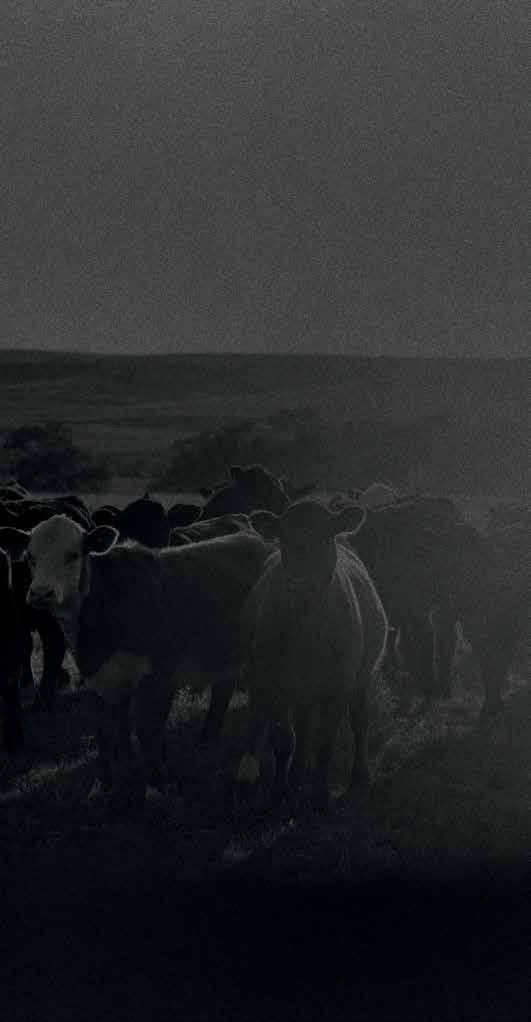
TOUGH ON TOUGH WORMS, EASY ON CATTLE PRODUCERS.
You can achieve effective parasite control in one product, where before you may have needed two. Valcor (doramectin and levamisole injection) is the first prescription cattle dewormer with two active ingredients in one dose. It’s never been easier to be tough. Get tough at ValcorTough.com.

IMPORTANT SAFETY INFORMATION: Do not treat cattle with Valcor within 15 days of slaughter. Not for use in female dairy cattle 20 months of age or older, including dry dairy cows; not for use in beef calves less than 2 months of age, dairy calves, and veal calves. Safety has not been evaluated in breeding bulls. Use with caution in cattle treated with cholinesterase inhibitors. This product is likely to cause injection site swelling; tissue damage (including granulomas and necrosis) may occur. These reactions have resolved without treatment. See brief summary of Prescribing Information attached.
trademarks are the property of Zoetis Services LLC or a related company or a licensor unless otherwise noted. © 2024 Zoetis Services LLC. All rights reserved. VLC-00028R1
All
Distributed by: Zoetis Inc. Kalamazoo, MI 49007 June 2022 40031685A&P TM Brief Summary of full Prescribing Information. S:8" S:10.5" T:8.5" T:11" 2 • Cow Country • July

As I pulled into my driveway this evening, my 2014 F150 had just south of 213,000 miles on it. I bought it new off the lot with an “on the road” price of an even $40,000. In the nearly decade I have had it, it has been highly reliable. I have probably spent around $10,000 on tires and rou- tine maintenance without significant repairs. Simple arithmetic tells me that owning that truck costs around $0.23 per mile. A quick Google search tells me that the same truck new today is about $60,000. The same Google search tells me that the truck in a 2023 version with less than 10,000 miles on it looks to be about $50,000. If you are someone who is driving a new truck every single year, it costs you roughly four times per mile what it is for me to own a truck that might need the upholstery cleaned but has shown no issues getting me from point A to point B. I am of the school of thought that you want to buy a ve- hicle with a lot of life left on it and drive it until it is suitable for nothing besides scrap metal. The more miles I can get out of a vehicle, the less per mile it will cost me to use it.
The same concept can be applied when evaluating heifer retention and cow cost decisions. How much more valuable is a cow that leaves your herd at ten years old compared to two? I can assure you the average cost per calf is much less the more calves you can get from a cow. If you are replacing a large percentage of your heifers each year, it costs you a lot more than it should be. Your cows may be what they call in the auto in- dustry a “lemon.” The job of a vehicle is to get me from point A to point B with as few headaches as possible. To me, the job of a cow is to give me a marketable calf each year with as few headaches as possible. I don’t care what model year she is. The longer either of them stays around, the better off I can be. Much like there will come a day when my truck no longer serves its assigned pur- pose, there will come a day when a cow has lived her life and is no longer a contributing member of the herd. The longer we go between purchase and disposal of either, the better off we will be financially.
Joe K. Lowe II M.S. Agricultural Economics

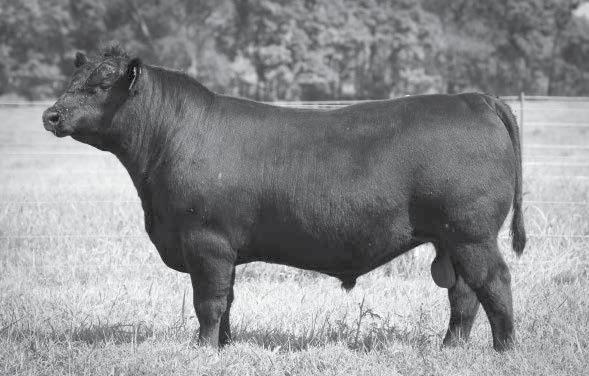
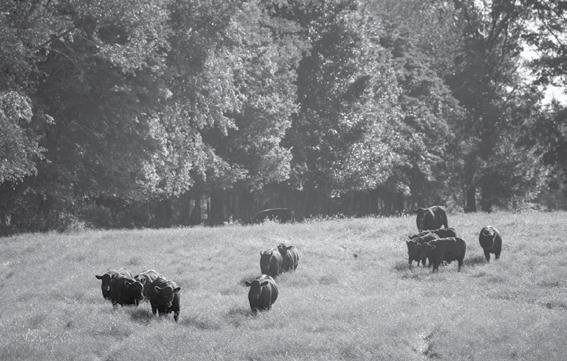
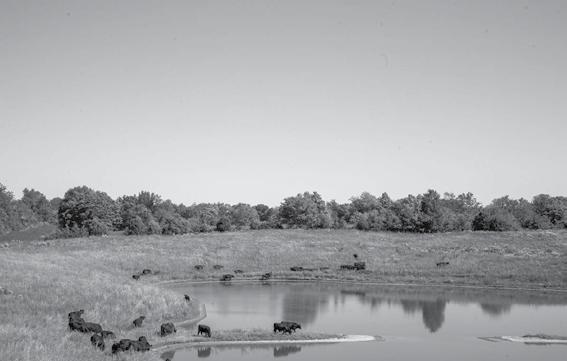
11TH ANNUAL FALL BULL SALE - MONDAY, OCTOBER 28, 2024 WWW.OAKHOLLOWANGUS.COM - KENNETH D. LOWE 270-202-7186 - JOE K. LOWE II 270-202-4399
July • Cow Country • 3
Oak Hollow Hallmark 2293 AAA 20537626- Semen is available through ABS.
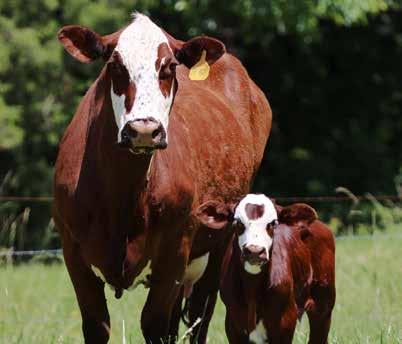
Relieve pink eye symptoms and promote healing through effective cleaning and flushing!
Treat and relieve eyes suffering from pink eye & other irritations
Safe for lactating dairy animals without a withdrawal period No alcohol, steroids, or antibiotics



TREATS
ANTIBIOTIC ALTERNATIVE, NO PRESCRIPTION * Administered once a day for 3 days BEFORE AFTER Consumer and Retailer: LIMIT ONE (1) COUPON PER PURCHASE OF SPECIFIED PRODUCT AND QUANTITY STATED. NOT TO BE COMBINED WITH ANY OTHER COUPON(S). LIMIT OF TWO (2) IDENTICAL COUPONS IN SAME SHOPPING TRIP. Void if expired, reproduced, altered, copied, sold, purchased, transferred, or exchanged to any person, firm, or group prior to store redemption, or where prohibited or restricted by law. Any other use constitutes fraud. Consumer: You pay any sales tax. Retailer: Innovacyn will reimburse you for the face value of this coupon plus 8¢ handling if submitted in accordance with Innovacyn Coupon Redemption Policy (available upon request). Mail coupons to: Inmar Dept #18582, Innovacyn Rcv Office, 801 Union Pacific Blvd, Ste 5, Laredo, TX 78045-9475. Cash value 1/100¢. No cash back if coupon value exceeds selling price. Valid only in the USA. EXPIRES: OCTOBER 31, 2024 MANUFACTURER’S COUPON $5.00 OFF Any one (1) Vetericyn ® Antimicrobial Pink Eye Spray 4 • Cow Country • July COLUMNISTS 07 Jeff Pettit President's Thoughts 08 Jonathan Shell Commissioner's Corner 10 Dave Maples Thoughts from Dave 22 Dr. Michelle Arnold Animal Disease Traceability Rule Part 2: Eartags 28 Chris Teutsch Winter Grazing Requires Planning 46 Jeff Lehmkuhler Keep Cool in the Shade FEATURE STORIES 12 The Value of Heterosis 16 The Cattleman’s Advocate 18 Santa Gertrudis Juniors ‘Swing for the Fences’ 20 Garcia Receives Santa Gertrudis Breeders International 2024 President’s Award 25 KVMA Announces New Program to Address Rural Vet Shortage 26 The Kentucky Rural Veterinarian Loan Repayment Program 14 County News 32 Membership 34 Kentucky Beef Council 36 Kentucky Beef Network 41 Kentucky Angus News 44 Calendar of Events 45 Advertisers Index 45 Classifieds
PINK EYE!
santa gertrudis breed spotlight
Cover photo by Darren Richmond taken at Windcrest Farm in Leitchfield


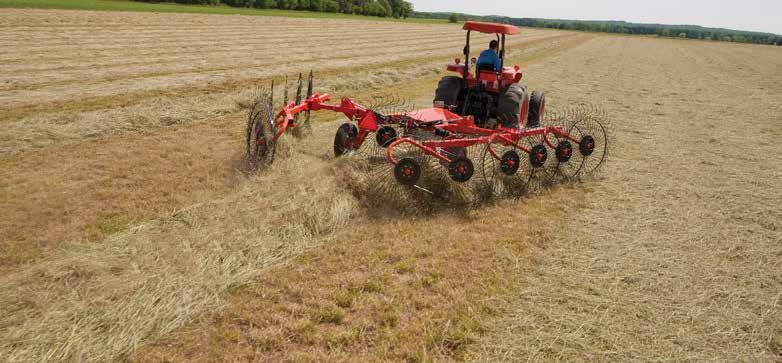




Visit your local KUHN Hay & Forage dealer today! Invest in Quality ® www.kuhn.com L.A. Yount Haying Equipment Pleasureville, KY Holbrook Equipment Campton, KY Rose Farm Supply Flemingsburg, KY McKeel Equipment Co Murray, KY Sanford & Sons Sales & Service Bowling Green, KY Siler Implement Corbin, KY Meade Tractor Georgetown, KY Richmond, KY MT. Sterling, KY Paris, KY, Harlan, KY London, KY, Somerset, KY Danville, KY SR 100 GII SERIES SPEEDRAKE ® | Wheel Rakes 15'10" – 23'4" working widths • 8-, 10- & 12-wheel models SIMPLICITY. VERSATILITY. QUALITY. Adjust windrow widths independently to match crop pickup widths Fast, easy switching between transport and field positions Rear wheels raise last for cleaner windrow ends Superior terrain following without the need for hydraulic float 2250 West Everly Brothers Blvd. Powderly, KY 42367 www.PogueChevrolet.com • 270-641-0300 www.PogueChrysler.net • 270-641-0400 LIGHT DUTY TRUCKS • HEAVY DUTY TRUCKS • AGRICULTURE REBATES WE’LL TRADE FOR IT, EVEN IF IT EATS! July • Cow Country • 5
EXECUTIVE
COMMITTEE
OFFICERS:
President
JEFF PETTIT Sebree
President Elect
RANDY WARNER Sharpsburg
Vice President
ALLAN BRYANT Eminence
Treasurer
KEN ADAMS Upton
Past President
ANDY BISHOP Cox’s Creek
KCA Program Chairman
DANIEL HAYDEN Whitesville
KBC Chairman
RYAN MILLER Lebanon
KBN Chairman*
ALLAN BRYANT
Beef Solutions Chairman*
DANIEL HAYDEN *ex officio
REGIONAL DIRECTORS:
REGION 1
Wayne Zoglmann, John Mark Brown, Ashley Holloway, Leland Steely, Gary Woodall, Coleman Ladd, Susan Zoglmann, Bill Plemmons, Kenton Howard, Sara Roberson
REGION 2
Phyllis Gentry, Joe Lowe, Allison Nissley, Rayetta Boone, Robbie Hatfield, Chris Imbruglio, Maggie Webb, Mike Jones, Corbin Cowles, Glenn Byrd, Isaac Thompson, Kenneth Green, Trent Jones, Brian Manion, Joe Mike Moore, Amy Cecil
REGION 3
Amanda Hall, Nathan Lawson, James Brown, Phillip Douglas, Larry Bryant, Lincoln Clifford, Abbey Biddle, Ben Tinsley, Kevin Perkins, Kyle Bush, Michelle Simon, Craig Retzlaff
REGION 4
Amy White, Brad Reynolds, Chad Anglin, Phillip Stamm, Danielle Harmon, Bruce Witt, Jodi Purvis, Mike Ravencraft, Ronnie Lowe, Danny Callahan, Jason Crowe, Rob Amburgey
REGION 5
Adam Chunglo, Brent Woodrum, Tommy Spalding, Dean Craft, Doris Hamilton, Rick Brewer, Brent Williams, Anne Bays, Terry Mattingly, Ryan Miller, Phillip Reese, Tommy Glasscock
Executive Committee members in bold
HelIo, I would like to introduce myself, Ivye Mattingly, as the current president of the Kentucky Santa Gertrudis Association along with our current board members: Pat Heath, vice president; Beverly Heath, secretary and treasurer; Cody Mattingly, sales chairman; and Roger Mattingly, Rodney Smith, David Smith and Chip Parker, board of directors. Currently, we are preparing for our 2024 sale at the United Producers Stockyards in Bowling Green. This year will be a little different from past years in that the junior show will be held separately in conjunction with a field day this upcoming spring. All members are encouraged to participate in this event as well as provide suggestions for activities for the juniors. Some of the activities already planned are meal, show, junior games and photo contest. We would also like to take time to recognize past board members during the spring event. A meeting is being planned for late this fall between Thanksgiving and New Years to start planning the field day, as well as planning for the 2025 show and sale. We are hoping for a time that will provide for the most participation as well as have quality time with our Santa Gertrudis family for the holidays!

KCA PAST PRESIDENTS:
1972-73 Jere Caldwell† - Boyle 2004 Paul Napier - Lincoln
1974-77 Smith T. Powell† -
Dave Maples Executive Vice President
Carey Brown Chief Operating Officer
Kenny Allen Beef Solutions Operations Manager
Kelly Baird KBC Director of Communications
Todd Brown Graphic Designer
Bradon Burks KBC Director of Education
Rachel Cain Membership and Communications Coordinator
Amelia Carter KBC Director of Industry Relations
Danny Coy Video Production Specialist
Jake Harrod KBN Program Coordinator
Dan Miller KBN Industry Coordinator
Debby Nichols National Advertising Sales, LAN
Katie Pratt Communications Manager
Alex Scott KBC Director of Nutrition
Becky Thompson Director of Kentucky Beef Network
Kelly Tucker KCA Collections & Compliance
Nikki Whitaker Director of Operations & Policy
limits its responsibilities for any errors, inaccuracies, or misprints in advertising or editorial copy. Advertisers and advertising agencies assume liability for all content of advertisements made against the publisher.
6 • Cow Country • July
VOLUME 37 • ISSUE 7 COW COUNTRY is published monthly by THE KENTUCKY CATTLEMEN’S ASSOCIATION. The publisher reserves the right to refuse any material which he feels is unsuitable for the publication.
CATTLEMEN’S
176 PASADENA DRIVE • SUITE 4 • LEXINGTON, KY 40503 (859) 278-0899 • WWW.KYCATTLE.ORG • INFO@KYCATTLE.ORG
Although the highest journalistic ethics will be maintained, the KENTUCKY
ASSOCIATION
Lincoln 2005 Eddie Young - Washington 1978-79 Larry Lovell† - Union 2006 Greg Ritter† - Barren 1980-82 John Masters† - Fleming 2007 Don Pemberton - Christian 1983-85 Seldon Hail† - Laurel 2008 Billy Glenn Turpin - Madison 1986-87 Bob Vickery† - Wayne 2009 Scotty Parsons - Christian 1988 Glenn Mackie - Bourbon 2010 Corinne Kephart - Shelby 1989 Dale Lovell† - Muhlenberg 2011 Greg Robey - Mercer 1990 Steve Henshaw† - Union 2012 Mike Bach - Bath 1991 Jerry Fraim - Grayson 2013 Don Reynolds - Hart 1992 Glen Massengale† - Wayne 2014 Steve Downs - Marion 1993 Dell King - Christian 2015 Gary Woodall - Logan 1994 Kenneth Lowe - Warren 2016 David Lemaster - Clark 1995 Dr. J.L.Cole - Monroe 2017 Chuck Crutcher - Hardin 1996 Harvey Mitchell - Mercer 2018 Bobby Foree - Henry 1997 Jim Naive† - Spencer 2019 Tim White - Fayette 1998 Shelby Hughes - Logan 2020 Steve Dunning - Christian 1999 Hoppy Lovell - Barren 2021 Chris Cooper - Madison 2000 Charles Miller - Jessamine 2022 Cary King - Mercer 2001 Larry Clay - Perry 2023 Andy Bishop - Nelson 2002 Jack Kimbrough† - Shelby 2003 Mark Williams - Crittenden †Deceased
photo by Darren Richmond
taken at Windcrest Farm in Leitchfield

President's Thoughts
Jeff Pettit KCA President
Hello fellow cattle producers,
I hope this article finds you and yours all doing well and either preparing for or just having had the opportunity and freedom to celebrate Independence Day in the wonderful USA!
We are so blessed to live in the greatest country in the world. I often consider those living in other areas of the world. While there are some nice countries, I feel none compare to the USA due to the opportunity and freedom we enjoy. I must thank God continually for placing me where he did!
Following that note, I recently had an opportunity to visit Seoul, South Korea, and Tokyo, Japan, as part of a group with the U.S. Meat Export Federation. Those are two countries that I probably would not have ever visited otherwise if it had not been for this opportunity. I am glad that I was able to go. The purpose of the trip was for producers to see firsthand the value of our beef and trade relations with those countries, and let me tell you, they love our American beef! It gave me a good feeling to know U.S. cattle producers are supplying a valuable, nutritional source of beef to people around the world that can’t produce enough food for themselves. One scary or sad note I learned is that both countries must import the majority of the food needed to feed their people. I hope we never allow that to be the case here in the United States. This fact made me realize that our ability in the U.S. to produce food is no accident, it’s by Gods design and
for his purpose, to feed his sheep around the world!
Trade can be a touchy subject for some, but as producers, we all depend on it to help maintain the profitability and sustainability of our own operations. I often ask myself the question, if we stopped exporting our beef, how many less producers and head of cattle would be needed in the U.S. to just feed our citizens?? That reduction would be substantial and put a large percentage of producers out of business overnight! Trade policies do have a dramatic impact on the price of food as well, and we saw that in these countries. Korea and Japan have protectionist trade policies in place that will not allow products to be imported that they produce themselves. For example, because they produce apples and melons, they had some of the highest produce prices I have ever seen. Apples were $5 each; cantaloupes were $50, and it seems like I recall watermelons started at around $20 each−ridiculous!
Due to the efficiency of our producers and good trade policies for the most part in the U.S., we have been blessed with reasonable food prices for our citizens. Citizens of other countries aren’t so blessed. If I remember correctly in Korea and Japan, the average consumer spends around 35% of their income on food alone. Stop and think about that.
Circling back to the thought I expressed earlier in the article, I leave you with a question, “How have you been blessed and equipped to help feed the world?
Luke 12:48 says, “From everyone who has been given much, much will be demanded and from the one who has been entrusted with much, much more will be asked.”
May God continue to BLESS the USA!!
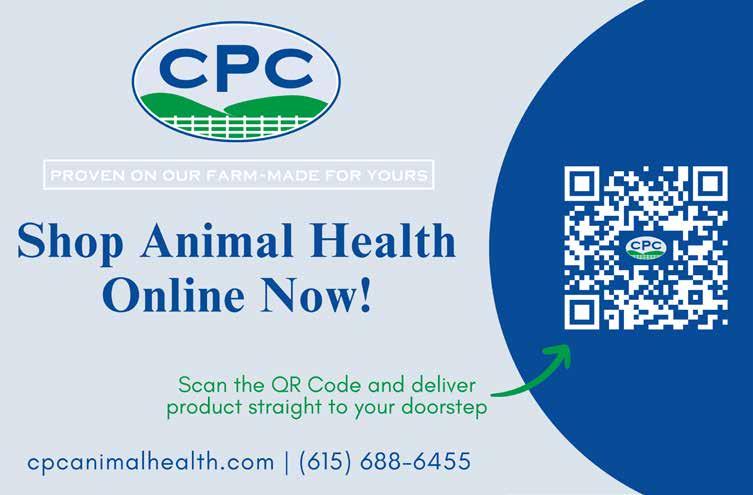
July • Cow Country • 7

Commissioner's Corner
Jonathan Shell Agriculture Commissioner of Kentucky
Access to nutritious food is critical to maintaining a healthy lifestyle.
That’s the reason the Kentucky Department of Agriculture (KDA) and I are joining forces with the Kentucky Hospital Association (KHA) to develop a “Food is Medicine” campaign focusing on the power of food and its connection to healthier living.
Advocating the connection between food and health is essential to meeting the goals of less chronic disease and longer lifespans for Kentuckians. But it’s more than a message about choosing the right foods; it’s also a message about expanding our food distribution networks within the agriculture industry.
Through increasing access to local, healthy food options, I’m working with Kentucky’s hospitals on crafting plans for a positive impact on communities across the state. This collaboration recognizes that high-quality nourishment, such as a diet rich in protein, is essential for well-being. Richer nourishment can result in healthier lifestyles, improved health and long-term positive results for individuals and communities.
Recognizing nutrition needs is one part of the overall goal, while creating consistent access to healthy food is another critical component. As part of this campaign, KDA will help Kentucky hospital officials connect
with local producers, giving hospitals access to nutritious food closer to their hospital locations.
Creating these local connections means food spends more time on the vine, in the ground or on the tree before it reaches its destination. When it comes to fresh foods, such as fruits and vegetables, the shorter time and distance from the farm to its destination, the higher the levels of vitamins and minerals.
Charolais Breeder Since 1962
Charolais Breeder Since • Bulls Available
Ø Bull calves out of HCR Answer HCR SPIRIT 4007.
Ø Bull calves out of HCR Answer 2042 and HCR SPIRIT 4007.
Despite the value of local food, a recent survey completed by representatives of 50 hospital systems across the state found that only about 2% of the hospital’s budget is spent on local food. The overall average percentage of local food being served at these same hospitals was 15%.
Ø Bred for calving ease and growth.
Bulls for both purebred and commercial breeders.
Ø Bulls for both purebred and commercial
Ø Bred for calving ease and growth.
Ø Yearlings and two-year-olds available.
CHAROLAIS BULLS & HEIFERS AVAILABLE
Ø Yearlings and two-year-olds available.
Ø Bred heifers to calve in fall available.
Ø Bulls for both purebred and commercial breeders.
Ø Bred heifers to calve in fall available.
Ø Yearlings and two-year-olds available.
Five areas of the campaign will include:
• Looking at the food a hospital is serving to patients
• Creating partnerships between hospitals and local farmers
John Allison, Owner 545 Eminence Road New Castle, KY 40050 502-220-3170
John Allison, Owner 545 Eminence Road New Castle, KY 40050 502-220-3170
• Connecting patients to consistent healthy food
• Creating outreach for patients who need a special diet (for example, diabetes patients, who could benefit from having a source of fresh food)
• Expanding existing initiatives that connect Kentuckians to healthy food options.
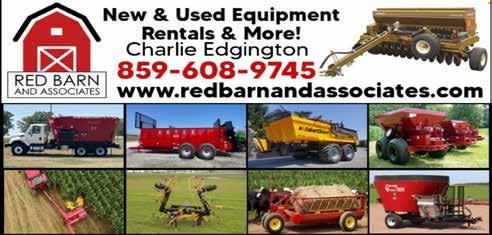
David Carter, Farm Manager 502-706-0075
John Allison, Owner 545 Eminence Road New Castle, KY 40050 502-220-3170
Ø Bred heifers to calve in fall available.
John Allison, Owner 545 Eminence Road New Castle, KY 40050 (502) 220-3170
David Carter, 502-706-0075
David Carter, Farm Manager 502-706-0075
As part of the “Food is Medicine” campaign, a working group including KDA, KHA, eight health system, and other key organizations will study how hospitals can play a key role in prescribing food as medicine to patients by creating more access to healthier and local foods.

8 • Cow Country • July ALL AGES WELCOME SCHEDULE A GROUP VISIT CHOOSE YOUR LESSON PLAN CATERING IS AVAILABLE VISIT US TODAY! BBURKS@KYCATTLE.ORG (859) 382-4303 CHAROLAIS BULLS AND BRED HEIFERS John Allison 545
New Castle,
220-3170 Allison Charolais Charolais
• Bulls Available Ø
Ø
Ø
Eminence Road
KY 40050 (502)
Breeder Since 1962
Bull calves out of HCR Answer 2042 and HCR SPIRIT 4007.
Bred for calving ease and growth.
Allison Charolais
•
Allison Charolais
Bulls Available

LIVESTOCK MARKETING GROUP
Blue Grass Albany
1274 Hwy 90 W
Albany, KY 42602
606-387-4681
Bret Carver, Manager 270-459-0724
Blue Grass Campbellsville 265 Airport Road
Campbellsville, KY 42719
270-465-4051
Ronnie Choate, Manager 270-766-8240
Blue Grass Internet Sales
4561 Iron Works Pike
Lexington, KY 40588
859-255-7701
Adam Menker, Manager 419-310-5344

Blue Grass East-Mt. Sterling 3025 Owingsville Road
Mt. Sterling, KY 40353
859-498-9625
Jeff Copher, Manager 859-229-7587
Blue Grass Lexington 4561 Iron Works Pike
Lexington, KY 40588
859-255-7701
Jeremy Shryock, Manager 859-967-6479
Farmers Stockyards
255 Helena Road
Flemingsburg, KY 41041
606-845-2421
Corey Story, Manager 606-209-1543
Blue Grass Richmond 348 K Street Richmond, KY 40475
859-623-1280
Jim Dause, Manager 859-314-7211
Blue Grass South-Stanford 277 Cordier Lane Stanford, KY 40484
606-365-0665
David Holt, Manager 502-680-0797
UPCOMING SALES
BG Lexington KY Simmental Assoc Sale
Saturday, September 28
KY Stud Wagyu Friday, October 11 & Saturday, October 12
Millenium Longhorn Friday, October 18 & Saturday, October 19
Southeastern Gelbvieh Alliance Saturday, October 26
KY Hereford Assoc Sale
Saturday, December 7

bgstockyards.com
#wearebluegrass
Watch bgstockyards.com for Special Sale Announcements!
out Blue Grass Stockyards Value Added Programs on the website at bgstockyards.com!
Check
July • Cow Country • 9

Thoughts From Dave
Dave Maples Executive Vice President
I had the opportunity to attend the 56th Annual BIF Research Symposium and Convention in June. BIF stands for the Beef Improvement Federation. The event was in Knoxville, Tennessee, at the University of Tennessee Institute of Agriculture.
In my prior job, I had the opportunity to attend the BIF meetings on a yearly basis, but at KCA, I have not always been able to do so for various reasons. With this year’s event being in Tennessee and with Kentucky’s Dr. Gordon Jones being the incoming president, I saw it as a good opportunity to attend.
I always liked this meeting because the topics were cutting edge and the ideas were of a nature that I enjoyed learning about. Don’t get
me wrong, some of the topics can be very complicated and difficult to understand, but it is also important to note that many of the tools that are common in beef production today were first discussed in previous BIF meetings.
This year’s event featured topics including “Modern Research and Modern Tools to Match Cattle Genetics to the Environment” presented by Jared Decker, University of Missouri, “Why is Cow Longevity and Maternal Performance Important” presented by Rick Machen from Texas A & M and Bob Weaber at Kansas State University, and “The Full Picture of Cow Efficiency” presented by Dave Lalman at Oklahoma State University. Darrh Bullock at the University of
Kentucky got in the mix with the topic of “Genetic Improvement Programs in the Fescue Belt”. If these topics are not what you were looking for, you could have attended the technical breakouts, where you could learn about topics such as the “Advancements in Genomics and Genetic Prediction”, chaired by Warren Snelling at the U.S. Meat Animal Research Center.
The nice thing about all of the above subjects is that our everyday cattlemen can use this information in a simple EPD format to make bull selections. However, you need to be listening to Lalman when it comes to cow efficiency. Building a productive, efficient cow herd is the base of the beef industry. The bull is only half of the equation. As I have

10 • Cow Country • July
been told, “You pay your bills with the steer calves, and you build wealth with the heifers.” There is a great deal of technology out there to help build a very nice cow herd. One could envision a day that you will sell your feeder steers on an individual genetic merit model. To do that, you will have to have the right bull mated to the right cow.
Other conference highlights include Red Hill Farms was awarded the prestigious seedstock producer of the year award. Bart and Sarah Jones along with Gordon and Susan Jones were well deserved recipients of this award. The Jones family and their Red Hill Farms push the envelope on innovation and performance practices in the beef industry. They are on the cutting edge of what is to come as the industry advances.
Also, Bullock was recognized with the Pioneer Award for his lifetime achievement with his work with BIF and beef cattle genetics.
BIF is a good organization and has done many nice things over the years when it comes to genetic improvement. It is an organization that blends academia, producers, breed associations, genetic suppliers and industry. It is also a great training ground for the next generation of scientists to display their master’s level work to the public. I thoroughly enjoyed the meeting and hope to attend future ones.




The Partner You Want.
Pasture. It’s your lowest-cost feed source.
When weeds and brush get in the way, you need solutions — simple solutions — because you’ve got enough to manage.
Range & Pasture products from Corteva Agriscience™ deliver those solutions so you can grow the best pastures and maximize your profit potential.
Contact me today and learn how to control these weeds and more:
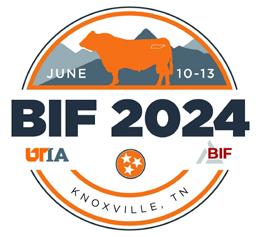
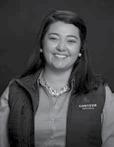
Rachel Walker
Range & Pasture Specialist
Primarily Serving KY, OH, WV, VA
Supporting Producers in IN, IL, PA, MI, and Northeast US rachel.walker@corteva.com
Mobile: (270) 995 – 9541

July • Cow Country • 11
@ CortevaPastures @ CortevaPastures @ CortevaPastures Corteva
Your Pasture Partners. HERBICIDE DuraCor ® PastureGard ® HL Remedy ® Visit us at rangeandpasture.com ™® Trademarks of Corteva Agriscience and its affiliated companies. Under normal field conditions DuraCor® is non-volatile. DuraCor has no grazing or haying restrictions for any class of livestock, including lactating dairy cows, horses (including lactating mares) and meat animals prior to slaughter. Label precautions apply to forage treated with DuraCor to manure and urine from animals that have consumed treated forage. Except for lactating dairy animals, there are no grazing restrictions following application of Remedy®. DuraCor, PastureGard® HL and Remedy herbicides are not registered for sale or use in all states. Contact your state pesticide regulatory agency to determine if a product is registered for sale or use in your state. State restrictions on the sale and use of Remedy apply. Consult the label before purchase or use for full details. © 2024 Corteva. RP - 21577 - KY COR (06/24)
Agriscience™
Honeylocust
Rose
Blackberry Multiflora
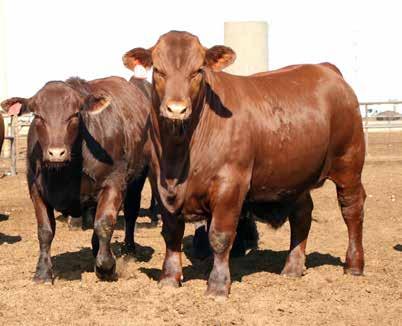
The Value of Heterosis
Chris McClure SGBI Executive Director
Often, it is a challenge to get the prices we hope to achieve for our cattle. This is especially true in geographic areas that have historically been labeled with fine-boned or health-challenged calves. Proper preconditioning of calves can help offset one part of that stigma, but rarely is it recognized if we simply sell our calf crop at the local auction market. There is normally no distinction in the price paid for preconditioned or backgrounded cattle vs. those weaned straight off the cow if they are sold one at a time.
Graded sales are one way to derive a better return on weaned calves than would normally be achieved by selling them at the local auction. Such sales typically attract a different set of buyers who recognize the value of preconditioning and sorting that goes into creating more uniform groups for marketing.
One thing that is often overlooked – whether selling at the local auction or through a graded sale – is the heterosis effect (also known as hybrid vigor) of crossbreeding cattle. The greatest impact comes from crossing a Bos taurus (British-type) animal with a Bos indicus (Brahmaninfluenced) animal. The resulting calves are usually growthier and will increase the number of pounds weaned per acre. They are also frequently thriftier and more resistant to disease and other environmental challenges. Many may argue that too much “ear” on calves significantly hurts their prices. Feeder calf buyers may offer less for “eared” cattle, but the fact that you are selling more pounds will generally more than offset that slightly lower price. One other thing to keep in mind is that many of the Bos indicus-influenced breeds have, through selective breeding, significantly reduced the “ear” of their cattle and
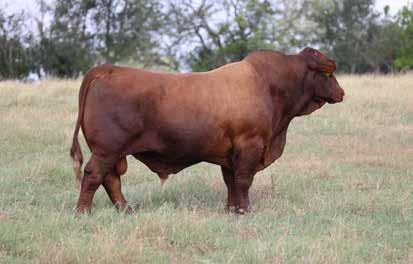
have also cleaned up their underlines. Because of this, their cattle are not hit with the types of discounts that have been historically encountered. While changing the appearance of these animals, some breeds, such as Santa Gertrudis, have also increased their marbling and ribeye size. The ribeye is an indicator of muscling which is easily visible when an animal walks into the sale ring.
A quick example is in order. If a typical British x British mating results in a 500 lb. weaned calf that will bring $275/cwt., the resulting check would be $1,375 before commissions, etc. Due to the impact of heterosis, mating a Santa Gertrudis bull with and British cow could easily result in a 575 lb. weaned calf under the same conditions. To break even with the previous British x British calf, the crossbred calf could bring as low as $240/cwt. If that weaned calf weighed 600 lbs. – which is very much in the realm of possibility – breakeven would be as low as $230/ cwt.
Market discrimination against eared cattle is real, but increased pounds from heterosis can yield an unexpected bonus in the check received. Not only in pounds, but frequently due to better health, more calves weaned and fewer lost due to a failure to breed, pregnancy losses or sickness after birth.
The emphasis on hide color in recent years has caused us to lose sight of many of the benefits of crossbreeding. It is time to remember those lessons and start marketing more pounds during these high prices.
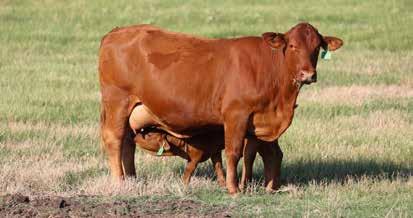
12 • Cow Country • July
Santa Gertrudis-sired calves in a Texas feedlot show all the characteristics of productive, profitable fed cattle.
Today’s Santa Gertrudis bull is a heterosis meat-wagon that throws calves with hybrid-vigor-enhanced growth, health and vitality.
The Santa Gertrudis female is a productive momma cow − .no matter if she’s got a fullblood or crossbred calf at side.

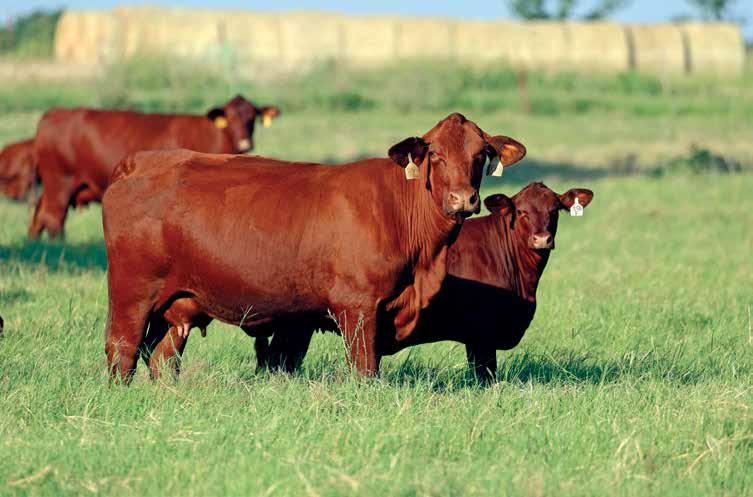
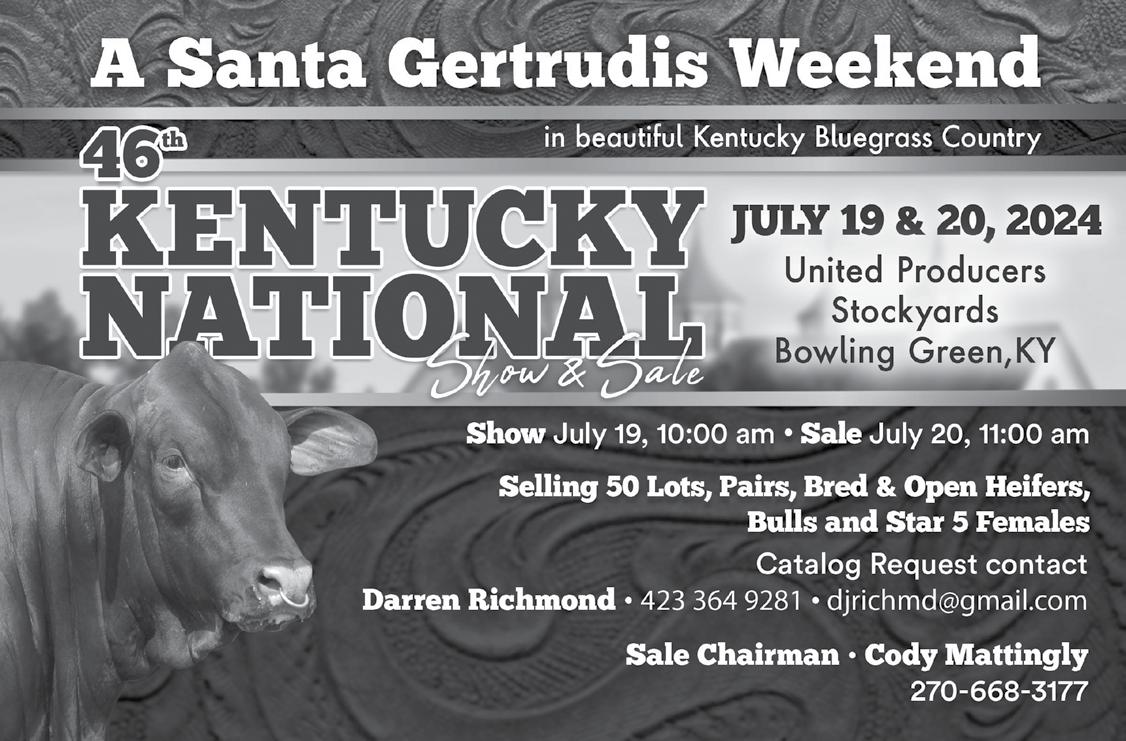
July • Cow Country • 13 SANTA GERTRUDIS BREEDERS INTERNATIONAL • (361) 592-9357 • santagertrudis.com SANTA G E R TRUDIS BREEDERS IN T ERNATIONAL Data Driven Profit Proven Invest in tomorrow’s cow herd. Use Santa Gertrudis today. Heterosis • Fertility • Adaptability Efficiency • Maternal Excellence
BARREN COUNTY NEWS
submitted by James W. Bailey
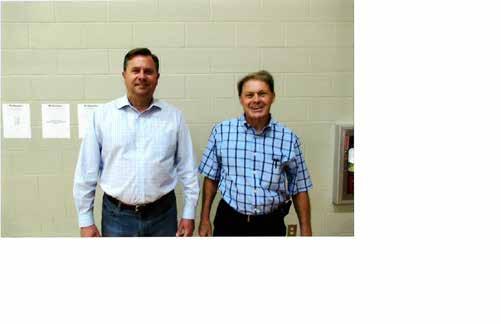
The Barren County Cattlemen’s meeting was held Thursday, May 9 at the Barren County High School Trojan Academy. During the meeting, Neal Branscum with Zoetis presented a program on animal health products. Pictured are Branscum and Glenn Byrd, Barren County Cattlemen’s Association program coordinator. Zoetis sponsored the delicious steak dinner that was served by association members. A very large crowd attended the meeting.
CHRISTIAN COUNTY NEWS
submitted by Caleb Johnson
The Christian County Cattlemen’s Association is gearing up for their 25th annual Lonestar Cattleman’s Scholarship Rodeo. It will be Aug. 16-17. This event, annually hosted at the Western Kentucky Fairgrounds, has become a staple in the community.
The Cattleman’s Rodeo attracts over 7,000 spectators and participants from all over the country. During the two-day event, contestants from 18 states and Canada compete in this thrilling event for the ultimate prize. Events include bull riding, team roping, cowgirl’s barrel racing, saddle bronc riding, cowgirl’s breakaway roping, and steer wrestling.
The cattlemen’s association has multiple food booths at this event



and serves up some real delicacies. Over the course of two days, they will cook over 700 of their locally famous Cattleman’s ribeyes. They also serve 200 pounds of whole smoked brisket as sandwiches and nachos and 600 hamburgers and 500 all beef hotdogs. This equals almost a half-ton of BEEF! Tasty treats such as fried pies, funnel cakes, fried Oreos, ice cream and a live concert are a huge hit.
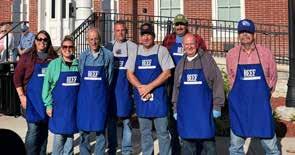
HENRY COUNTY NEWS
submitted by Catherine Atchison
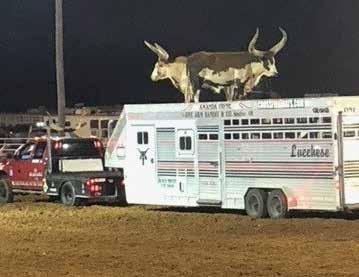
To date, the association has handed out over $200,000 in scholarships to local youth and young adults in high school and college from rodeo proceeds.
The association would like to extend an invitation to any all chapters and cattlemen’s members across the state to attend this year’s event. It is truly a first class rodeo event, and you will not be disappointed.


The Henry County Cattlemen’s Association grilled at the courthouse in New Castle to celebrate beef month in May. Members of the grilling team included Alicia Woods, Catherine Atchison, John Allison, Shaun Woods, John David Yount, Tim Robinson, Billy Quire and Phillip Douglas.
14 • Cow Country • July
LINCOLN COUNTY NEWS
submitted by Tyler Miller
The annual Chamber of Commerce banquet was held at the Arcadia Manor in Lincoln County. It’s been a longstanding tradition for the cattlemen to cook the steaks for the event. With all hands-on deck and plenty of laughter, the steaks turned out great. LCCA enjoys cooking and working with one another, but promoting a product that we all can enjoy and work so hard for
is the driving factor behind our motivation.
I have always believed credit should be given when credit is due. Stanley Burris was awarded the high honor of Farmer of The Year during the chamber banquet. Stanley is a member of LCCA where he currently serves as secretary and is also a member of the Casey County Cattlemen’s Association.
ROBERTSON COUNTY NEWS
submitted by Samantha Saunders
In May, the Robertson County Cattlemen’s Association hosted their spring member appreciation meeting. This meeting was designed to recognize and thank the members and their families for their efforts with the association. The meal included ribeye steaks, green beans, macaroni and cheese, a roll, a salad and a choice of pie for dessert. During the meeting, Randall and Susan Wood from Total Tax Service discussed the ins and outs of farm income taxes. This topic is often brought up at multiple functions and
is very helpful no matter how long producers have been farming and filing farm income taxes. Members were able to enjoy the meal and fellowship while also learning about a very important topic.
The association would like to thank their Cattlemen’s Board for preparing the meal, Kentucky Cattlemen’s Association for sending items to give to members, Farmer’s Stockyards for providing door prizes and Hinton Mills for sponsoring the meal.
SHELBY COUNTY NEWS
submitted by Tanya Wilson
Shelby County celebrated Beef Day on May 13 at the fairgrounds by providing free hamburgers, mac-ncheese, baked beans and ice cream to community members from 11 a.m.2 p.m. They served 420 plates to the local community. This event was hosted by Shelby County Cattlemen’s Association, Shelby County Farm Bureau, Shelby County Farm Credit and Shelby County Dairy Club.
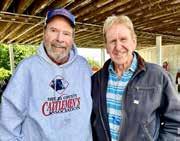
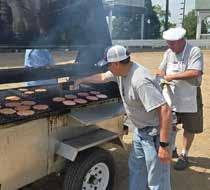
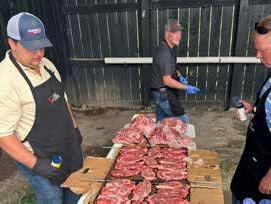
Stanley farms in both counties and devotes his efforts to both counties’ cattlemen’s events throughout the year. He is the type of individual that you want on your team, and Stanley is on Team Cattlemen!!
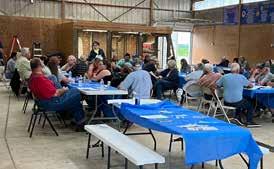
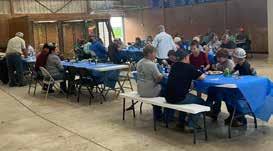
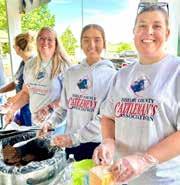
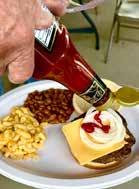
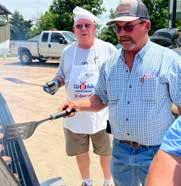

July • Cow Country • 15
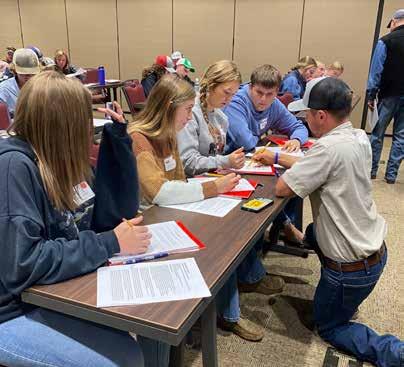
The Cattleman’s Advocate
Katie Pratt Kentucky Cattlemen's Association
If producers have been to a county cattlemen’s association meeting anywhere in Central Kentucky or a statewide cattle-focused event, they have likely encountered Jacob Settles, Kentucky Beef Network field associate.
“His work ethic is unmatched. He is a work horse,” said Tyler Miller, Lincoln County agriculture and natural resources extension agent. “He is also willing to get in a truck and drive to talk to producers at any time of the day. It’s hard to find a person willing to do that these days.”
Miller said Settles has done everything from speaking and setting up booths at the Lincoln County Cattlemen’s Association meetings to parking cars, grilling and passing out food. Miller said Settles also advocates for industry events like CPH sales, Beef Solutions and the Kentucky Beef Network. Settles and Miller have partnered to host a Pastures to Pastors event where local producers invite their ministers to tour local cattle operations so they can get a better understanding of the industry.
Settles makes it a point to attend as many events as he can, often offering producers some form of education about the industry or the Kentucky Beef Network and immersing himself in the area’s cattle community.
“I want to see and be seen by cattle producers because it gives me an avenue to connect with them,” Settles said. “They are not going to call you if they do not know who you are.”
Carving his own path
Settles joined the Kentucky Beef Network in 2017, but he grew up around the organization and in the cattle industry. His father, the late Jeff Settles, was actually one of the first
Kentucky Beef Network field associates hired in 2001. He held the position Jacob holds today until his death in 2007. Settles also continues to raise cattle for his family’s freezer beef operation that his father started.
“I do a lot of the same stuff that dad did,” Jacob Settles said. “I do it not to be like him, but I do it because I saw the good things that he was able to accomplish, and I have the same passion for a lot of the same things that he did.”
Settles’ wealth of knowledge about the cattle industry makes him a valuable asset to the producers in his area which extends from just north of Louisville to Whitley County on the Tennessee line.
Just a call away for producers
Casey County producer Chad Meece has worked with Settles for the past three years after meeting him a county cattlemen’s association meeting. Meece is in the process of revamping his commercial cow-calf operation and incorporating some registered Angus cattle into his herd.
“I want to raise good quality animals that stay on my farm so I’m not paying someone else for theirs,” Meece said. “I’m also trying to select for a more moderate-sized cow so I can keep feed costs down.”
Settles has helped him with pasture herbicide selection, culling decisions, heifer selection and retention, and cattle pregnancy checking and working.
“I contact him with anything I think of trying,” Meece said. “Jacob usually has the answers. He’s really helped me a lot, especially as I have begun to transition to registered Angus.”
Due to the advanced age of Meece’s herd, he’s had to cull several animals as he works toward better efficiency. Settles encouraged him to sell his cull livestock to Beef Solutions, which produces and markets Kentucky Cattlemen’s Ground Beef. Meece said he has told his neighbors that he had a good experience with the program,

16 • Cow Country • July
and he plans to sell more into it.
“I’m happy with that way that turned out,” he said. “The animals brought better than they would have at the stockyards. Plus, I didn’t have to pay commission.”
Bullitt County producer Jewett Borden has been heavily involved with the Kentucky Beef Network and Settles’ predecessors and continues to work with Settles today. He raises purebred Santa Gertrudis cattle and has a finishing facility on his property. He also sells his beef by the package.
“I lean on Jacob in all aspects of my operation, and we will bounce ideas off of each other,” Borden said. “The size of my facility has doubled or tripled since I started working with him. We have also improved my cattle’s nutrition and the quality of my feed so I am able to make the most of my hay.”
Settles has also assisted Borden with the numerous field days he hosts on his farm. Located just south of Louisville, Borden regularly hosts education events on his farm for numerous groups including FFA students, the county cattlemen's association, Santa Gertrudis breeders and University of Louisville nursing students. He’s also assisted with herd health field days for producers where a large animal vet will demonstrate the proper techniques to work cattle.
“Jacob has helped run the field days and will work a station,” Borden said. “He will talk about things like our stack pad and why we have it as well as genetics and AI.”
Assistance with education and marketing
Settles is also highly involved with the Casey County Cattlemen’s Association Liberty Belle Sale for heifers and young cows. The sale started as a way to give producers a local place to market their young females and as a way to improve the county’s cattle genetics. Animals in the sale are eligible for County Agricultural Investment Program funds. Settles helps educate producers on how they can
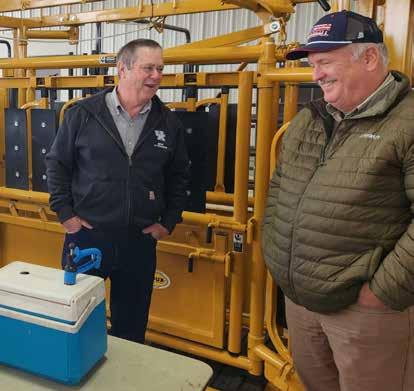
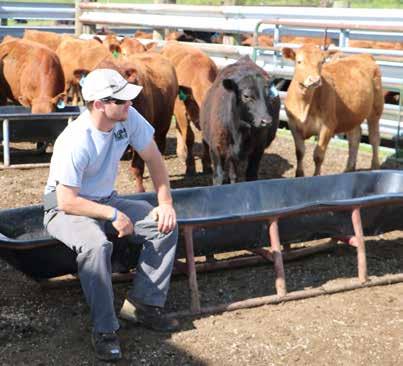
meet the sale’s CAIP and health requirements. He also helps with procurement.
To help producers understand the sale requirements, CAIP requirements and how to properly develop heifers soon after the sale began, Settles played a part in organizing a heifer development field day at Casey County producer L.J. Watson’s farm. Over the years, he’s also helped Watson with other tasks on his farm.
“Jacob will always help me if he possibly can,” Watson said.
Settles and Kelsey Marcum, Casey County agriculture and natural resources extension agent, will travel to consignors’ farms and screen the heifers before the sale to make sure they meet the sale requirements. They will conduct physical evaluations, check body condition and make sure the animals do not have ringworm or pinkeye.
“Jacob is very personable and enjoys working with the cattlemen in our county,” Marcum said.
More recently, Settles had a role in a research project led by Merck Animal Health and in partnership with the Kentucky Beef Network and the University of Kentucky. The study looked at the effectiveness of current dewormers in different classes of animals. In the study, he worked with producers to collect initial fecal samples from cattle, and he sampled again two weeks after they applied a commercial dewormer of their choosing to determine if the dewormers were reducing parasite numbers or if there were certain parasites were developing resistance. While the specimen collection concluded in 2023, results have not been released yet.
End goal
Settles’ ultimate goal is to help producers become better, more efficient cattlemen.
“I really enjoy doing what I can to help other guys improve their operations,” Settles said. “Sometimes that can take years, but it feels good when you can help someone else."
July • Cow Country • 17

Santa Gertrudis Juniors ‘Swing for the Fences’
Christy Fuchs Moran GOALS 2023 Co-Chair
Forty members of the National Junior Santa Gertrudis Association (NJSGA) represented the breed at the 2023 Gerts Ongoing Advanced Leadership Summit (GOALS) in Louisville, Ky., July 25-29, 2023. These youth and five adult chaperones gathered in Falls of Rough, Ky., at the Rough River Dam State Park to share in five days of leadership development, team-building fun, Kentucky tourism and agriculture-related experiences.
Held every other year, GOALS is a hands-on, interactive and diverse program that is held in various U.S. locations and exposes young cattle producers to new sights, environments, production systems and people. Kentucky was a fantastic location for GOALS 2023.
Young leaders representing six states (Texas, Mississippi, Florida, Louisiana, Arkansas and New Mexico) participated in the event that led them on new adventures, allowed them to gain valuable leadership skills and provided interactions with many wonderful Santa Gertrudis
friends for a memory-making event. The theme of “Swing for the Fences” was a common thread experienced throughout the week.
Their time at the Rough River lodge began with an evening of ice breakers and introductions so everyone could get to know each other through fun and interactive games. Leaders introduced the task of writing Happy Grams, which ended up being a hit of the week. Juniors wrote notes throughout the week that shared inspirational notes of kindness, respect, compliments and encouragement for other attendees. These notes were placed anonymously in envelopes for them to take home at the end of the week. This exercise was a powerful tool for juniors to learn to express themselves and also share kind sentiments with others.
The first full day at GOALS kicked off with leadership development led by YourNextSpeaker, Rhett Laubach. Laubach, a seasoned GOALS guest, led multiple educational and
inspirational sessions to encourage participants to learn more about themselves and those around them, explore their self-worth and learn how to be better leaders and citizens.
Outside the classroom, juniors experienced active bonding and teambuilding activities through an intense tournament of wiffle ball, as well as recreational activities and a GOALS Beef Cook-Off.
A full day was spent in Louisville to take in Kentucky tourism. At Churchill Downs, juniors went to the “backside” of the track for a tour of the stables and training center and then enjoyed breakfast at Wagner’s Track Kitchen, where they watched the horses work out and race. Participants stood inside the track starting gates before touring the grandstands and learning about the facility’s history. Last, they visited the amazing Kentucky Derby Museum. Next was the Louisville Slugger Factory and Museum where they ate lunch in the factory loft and took a
18 • Cow Country • July
The 2023 GOALS group at Cedar Creek Farms in Shepherdsville.
close-up tour of the bat factory to witness custom professional bats as well as retail wooden bats being made from a piece of crude timber wood into to a beautiful, expensive, iconic Louisville Slugger. The kids got to tour the museum, try out bats from professional players, hit balls in the batting cages and even customize bats to order and personalize for themselves.
These two stops on the Louisville tour provided a look into agricultural arenas different than the beef cattle industry. Learning about the equine and horseracing industries as well as the timber industry were fun agricultural tourist attractions for the young people.
The juniors had a daylong, full experience in Shepherdsville at Cedar Creek Farms, a Santa Gertrudis ranch owned and operated by Jewett Borden, Santa Gertrudis
Breeders International (SGBI) board member and District 5 director. Borden raises Gert cattle in a farm-to-finishing operation with a meat market. It was very neat to see a Santa Gertrudis breeder fully involved and thriving in his work and livelihood. This field day also shared a variety of educational rotations ranging from farm equipment safety to beef grading, genetics and feeding programs to achieve higher quality cuts of beef, to veterinary care and breeding. Youth also heard from representatives from the Raising Hope Farmer Wellness program, Farm Bureau and the Department of Agriculture, who are all working together for the good of Kentucky agriculture. They then enjoyed a dinner made with Cedar Creek meat at The Kitchen Table restaurant to close a great GOALS trip.
All these events provided
“Trees keep my land from washing away. My plan protects my farm.”
opportunities for growth, development, learning and fun. These kids really used this trip for positive self-development for themselves and others, and this was shared by attendees and parents with mentors and chaperones, as well as verbally in reflections session at the end of GOALS. The NJSGA Board of 15 youth also met to plan the new year. They also spent time talking about how this trip was made possible and sharing their thanks through a thank you notewriting session to understand the importance of sharing gratitude with others.
All of this was made possible because of one common bond –membership in the National Junior Santa Gertrudis Association. For more information on this program or the Santa Gertrudis Breeders International, visit https:// santagertudis.com.
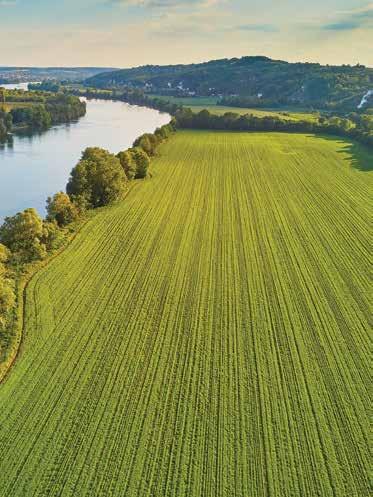
Preserving and protecting our land and water resources is all of our responsibility. By developing an Agriculture Water Quality Plan and implementing best management practices, you can protect water quality and promote soil conservation on your farm. The result: a healthier environment for future generations, and a more profitable farm today. To learn how to develop your own ag water quality plan, go to eec.ky.gov/agwater.
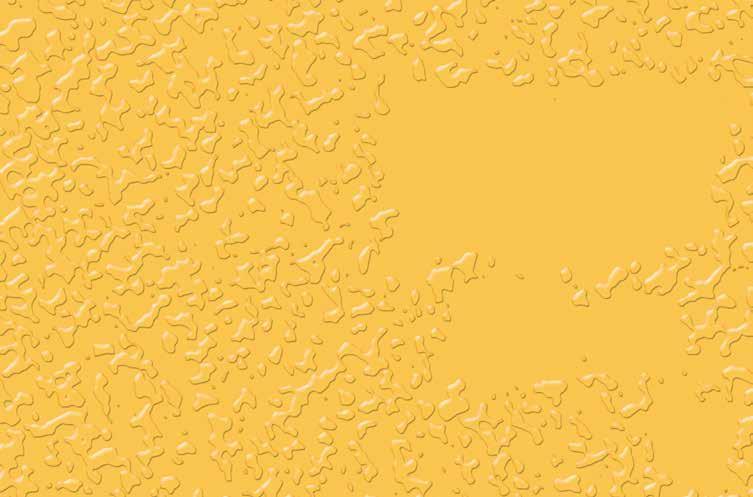
July • Cow Country • 19
Garcia Receives Santa Gertrudis Breeders
International 2024 President’s Award

MYRTLE BEACH, S.C.,(May 31, 2024) – Matthew Garcia, director of the Texas Christian University (TCU) Ranch Management program, received the Santa Gertrudis Breeders International (SGBI) President’s Award April 27 during the association’s 73rd Annual Meeting in Myrtle Beach, South Carolina.
Prior to his appointment as TCU ranch management director, Garcia served as the Utah State University (USU) extension beef specialist, where he spearheaded a multiyear heterosis project utilizing Santa Gertrudis cattle. Garcia was recognized for his work in the area of heterosis, and in particular for the leadership he provided to the USU heterosis project.
“Dr. Garcia was the best fit for the 2024 SGBI President's Award,” says Adolfo Sanchez, SGBI president. “His contributions to the Santa Gertrudis breed have been tremendous to both seedstock producers and commercial cattlemen. His willingness to study the impact of heterosis with Santa Gertrudis on Angus genetics was a bold move in today's beef industry climate. Such research is needed to advance cattle production in environments not suitable for crop production and to enhance net profits for the next generation of commercial cattlemen.”
The project, a collaborative effort between SGBI and USU, is now in its seventh year and is recognized as one of the most comprehensive studies of hybrid vigor conducted in
the United States. The project has dispelled many of the misconceptions associated with Bos indicus genetics and specifically demonstrated that Santa Gertrudis-influenced genetics are capable of adapting to northern environmental conditions, can reach Choice quality grades at a level similar to their Angus-influenced counterparts, and that they are as efficient, if not more so, than their Angus counterparts in feed conversion.
“Prior to the implementation of the USU heterosis study, there were a limited number of Santa Gertrudis bulls and Santa Gertrudis genetics in herds across Utah,” Sanchez said during his presentation of the award to Garcia. “Following six years of the project, the number of Utah producers utilizing Santa Gertrudis bulls in their operations has increased from one to approximately 15.”
Currently, USU-based researchers are focused on evaluating longevity, heat tolerance and resilience in Santa Gertrudis F1 females being retained as replacements.
Santa Gertrudis Breeders International provides progressive leadership, services, programs and technology to promote and broaden the long-term profitability of Santa Gertrudis influence within the beef industry by being member driven and consumer focused. For more information about Santa Gertrudis cattle and Santa Gertrudis Breeders International, visit www. santagertrudis.com.
20 • Cow Country • July
Matthew Garcia, left, receives the Santa Gertrudis Breeders International 2024 President’s Award from SGBI President Adolfo Sanchez
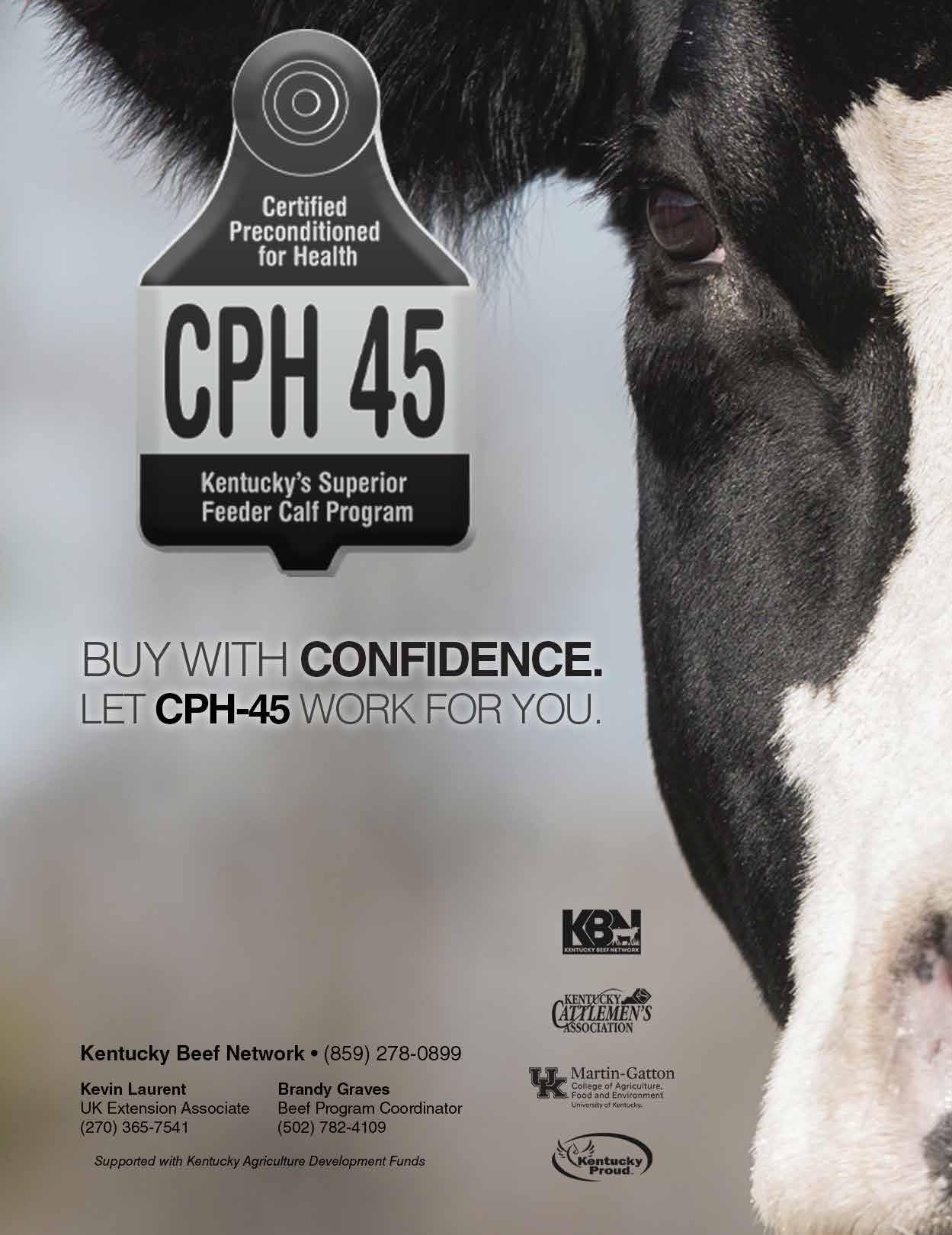
SALE DATES 06 Guthrie 08 Owensboro DEC 05 Owensboro DEC 10 Guthrie FEB 20 Owensboro AUG AUG

Animal Disease Traceability Rule Part 2: Eartags
Michelle Arnold DVM (Ruminant Extension Veterinarian, UKVDL)
The new Animal Disease Traceability (ADT) rule titled, “Use of Electronic Identification (EID) Eartags as Official Identification in Cattle and Bison,” was published in the Federal Register on May 9 and will be effective on Nov. 5. This final rule, available at https:// www.regulations.gov/document/ APHIS-2021-0020-2011, is an amendment to the animal disease traceability regulations already in place as of January 2013. One stipulation in the new rule requires eartags to be both visually and electronically readable to be recognized as official eartags for interstate travel for cattle and bison covered under the regulations. This final rule does not require exclusive use of eartags; the regulations continue to list eartags as one of several forms of authorized official identification, which also include tattoos and brands when accepted by state officials in the sending and receiving states. This article will address questions about eartag differences with regards to the new rule. For more in-depth information, there is a new guidance document titled “Official Animal Identification Number (AIN) Devices with the “840” Prefix,” published May 14. It is available at https://www.aphis.usda. gov/media/document/64512/file . What does it mean that an official tag must be “visually and electronically readable” for interstate travel? Are the RFID “button tags” considered visually readable or will flop tags/ panel tags be required?
All tags must be readable in cattle, but USDA now has device readability standards, both electronic and visual standards, that must be met by tag manufacturers to obtain approval for official identification purposes that meet interstate travel requirements. In Version 3.0 of the ADT Device Standards, released Sept. 21, 2023, the specifications are described in detail regarding readability:
• Electronic ID eartags are required to be visually readable for a person with 20/20 vision (arm’s length) viewing from 2.5 feet (30 inches). RFID button tags meet this standard, so a panel tag is not required in order to be “visual.”
• All official identification numbers must be imprinted at a minimum height of 5 mm (0.2 inches) on a bright, contrasting background. An exception may be made for small EID eartags that do not allow the imprinting of the official identification number at 5 mm but are clearly read at the required distance.
• For 840 tags, a space must be inserted after each third digit of the animal identification number (AIN) imprinted on the tag (for example, 840 003 123 456 789).
• The font for all characters for required information imprinted on the tag must be Arial. APHIS must approve any different font. Electronic ID eartags can also be read using an RFID reader. This reader sends a radio signal of a specific frequency to the eartag and records the number that comes back from the eartag. Once a signal is received from the reader, the eartag transmits the identity of an animal in the form of a unique 15-digit sequence of numbers. The 15-digit sequence begins with the country code (e.g., 840 for U.S.-born animals), followed by 003, then 9 unique digits. Official USDA-APHIS electronic eartags have no batteries or active transmission of information but are often categorized by the radio frequency range they use to communicate, either low (LF) or ultrahigh frequency (UHF). Low frequency tags have a shorter read range and only one tag can be read at a time. The transponders must be reliably machine read at a rate of 95% as cattle move by in a single file passage at 4 mph. UHF has an extended read range of up to 30 feet, faster data transfer and is better
suited to capturing load lots of cattle. UHF transponders must be reliably machine read at a rate of 95% at the read distance designated by the device manufacturer.
Why the push for both visually and electronically readable official tags?
Reading eartags electronically does not require restraint of animals because animal identification information is captured almost instantaneously by scanning the eartag with a reader. Once the tag is scanned, the tag number may be rapidly and accurately transmitted to a connected database. Electronic databases store only data associated with an eartag number that is necessary to perform traceability of animals; no business practices or other financial or competitive information is obtained or stored. Electronic eartags help animal health officials more quickly locate the records associated with an animal during a disease trace to identify the origin of the animal. If the animal was tagged with an electronic eartag, the tag distribution records are in APHIS’ Animal Identification Number Management System database (AIMS), which are easily accessible to animal health officials and provide the starting point for the trace. However, if visual only tags have been used, the animal must be restrained to allow the eartag number to be read and recorded. Often, the eartag must be cleaned before the number can be read. The eartag number is then recorded on paper or manually entered in a database and errors can occur while reading, transcribing or entering the tag numbers. If the animal was tagged with a visual (non-electronic) eartag, there is no centralized tag distribution database and obtaining records often requires a lengthier search and further verification.
This final rule does not require producers or livestock markets to have electronic reading equipment or
22 • Cow Country • July
additional data management systems, because the official electronic ID tags must be readable visually as well as electronically. It is important to remember that producers should not sell, loan or give tags they have purchased to other producers, because all 840 ID tags they have purchased are recorded as being distributed to them using the location identification system (Premise ID) used by their state. APHIS maintains an Animal Disease Traceability webpage with direct access to the Final Rule, FAQs, how to obtain free electronic ID tags and other resources at https://www.aphis.usda.gov/ livestock-poultry-disease/traceability.
RFID tags were previously categorized as either “Low Frequency” (LF) or “Ultra-High Frequency” (UHF). This final rule now uses the acronym “EID” instead of “RFID” and refers to EID tags as “HDX” or “FDX”. What happened? The new rule refers to electronic identification (EID) tags rather than radio frequency identification (RFID) tags to recognize the possibility of other electronically readable technology that may become available in the future. Electronic eartag technology can be categorized by the way information is transferred between the tag and reader, either “Half Duplex” (HDX) or “Full Duplex” (FDX). HDX tags are heavier. They transmit information one way at a time. They are better able to transmit through interference such as metal objects. They have the strongest read range and are slightly more expensive than FDX. FDX eartags are lighter in weight. They transmit information continuously but are more susceptible to interference from metal objects and fluorescent lights, and they have a shorter read range. Both technologies work well and have similar qualities but have different strengths and capabilities so the choice depends on where and how it will be used (Figure 1). Regardless of type, all electronic ID tags must be approved by USDA and meet standards for quality and performance, be tamper proof, contain a unique ID, the words “Unlawful to Remove” and display the

Type
Size
Color
Tamperproof Cap
Button Back Included
Read Range
Half Duplex (HDX)
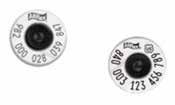
Global (962) and USDA (840)
Yes - Tamperproof Ultra Cap provides ultimate security and retention
Yes - Extended Male Button Back
15" - 18" - HDX technology optimizes signal transmission and provides greatest possible read distance.
ISO Compliant Yes
Matched Pair Option Yes
RFID Reader
Allflex Applicator(s)
All ISO compliant readers includeing
Allflex AWR300, RS420, LPR, and TruTest RFID Readers
Universal Total Tagger, UTT3S, Total Tagger Plus and EID Ultra Retractomatic
Comments Works well in all operations. Best and strongest read range.
Full Duplex (FDX)
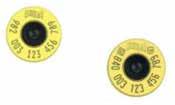
Global (982) and USDA (840)
Yes - Tamperproof Ultra Cap provides ultimate security and retention
Yes - Extended Male Button Back
13" - 16" - FDX technology is sufficient for capturing data, if read range is not an issue.
Yes
Yes
All ISO compliant readers includeing Allflex AWR300, RS420, LPR, and TruTest RFID Readers
Universal Total Tagger, UTT3S, Total Tagger Plus and EID Ultra Retractomatic
Works well for most operations. FDX tags are more susceptible to interference from metal and steel objects such as head gates, panels, and squeeze chutes as well as flourescent lights.
Figure 1: A comparison of HDX and FDX tags, courtesy of Allflex. Accessed 6/6/2024 at https://www.livestocktags.com/blogs/learning-center/allflex-electronic-id-tag-comparison.
U.S. official eartag shield. Both HDX and FDX tags follow the ISO standard and can be read by the same readers. HDX tags talk to the reader like a two-way radio; the reader sends out a signal then the tag replies. A half-duplex RFID reader generates short magnetic pulses that wirelessly charge a capacitor inside an HDX tag. When the charge field turns off, the tag uses the stored power to send the tag number back to the reader without interference from the reader. HDX uses Frequency Shift Keying (FM) which has better noise immunity and allows larger, simpler antennas. Since the charge field is pulsed, HDX readers require less power. Half Duplex (HDX) tags are (generally) white in color. They are better suited to transmit through metal interference such as metal and steel objects. Typical read range on HDX tags ranges from 15" - 18". FDX is like a phone conversation; as soon as the tag receives the reader signal, both tag and reader talk simultaneously. A full duplex RFID reader generates a continuous magnetic field which powers the tag to respond immediately. Tags repeat their message while powered by the
field, up to 30 times per second. FDX tags can be made very small and thin due to their simple construction of a coil, ferrite rod and a chip. Very small tags have a short read range and so are primarily used for hand scanning. FDX uses Amplitude Shift Keying (AM) and is susceptible to atmospheric noise which limits antenna sizes. Full Duplex (FDX) are (generally) yellow in color and are good when the read range is short (13" - 16"). FDX tags are more susceptible to interference from metal and steel objects such as head gates, panels, squeeze chutes, as well as fluorescent lights.
What is the difference in cost between HDX and FDX tags?
The cost of EID official identification tags varies by tag type and quantity purchased. USDA performed a market analysis in 2022 and found the cost per FDX tag ranged from $2 for large quantities (5,000+) to $3.45 for smaller quantities (20 tags). The advertised retail price per HDX tag in August 2022 ranged from $2.32 for large quantities (5,000+) to $3.65 for small quantities (20 tags). Depending on the tag type, many vendors that handle official ID tags offer volume discounts and free
July • Cow Country • 23
CONTINUED ON PAGE 24
HDX Tag weight:
FDX
weight:
8.9 grams
Tag
5.6 grams
White Yellow

Figure 2: Commerce Compliant ADT (Allflex). Accessed 6/6/2024 at https://www.allflex.global/na/wp-content/uploads/sites/7/2022/04/Commerce-Compliant-ADT_ADP003_R6.pdf.
shipping for large orders.
When shopping for USDA-approved tags, manufacturers offer “visual tags”, “RFID tags” (FDX and HDX), and “RFID with visual matched (paired) sets”. Are “visual” tags with no electronic or RFID component still official?
The minimum identification standard in cattle is the visual 840 tag. For visualonly tags the entire official identification number must be imprinted on the portion of the tag inside the animal’s ear. This will suffice if the cattle never leave the state of origin within their lifetime, however, interstate travel requires a tag with electronic capabilities. For electronic ID tags, the entire 15-digit official identification number beginning with 840 must be imprinted on the portion of the tag containing the transponder encoded with the identical official identification number (Figure 2). Be aware that manufacturers still sell tags beginning with 900 numbers used for in-herd data use only and cannot be used as official ID.
Many of the new tags display a data matrix; what comes up when scanned with a cell phone?
The 2D Data Matrix that conforms with the ECC200 Data Matrix protocol must be imprinted on the portion of the tag that contains the transponder in a square approximately 5mm x 5mm and should be a two-dimensional representation of the official animal number imprinted on the tag. Readability (percent of data matrix read) on new tags being shipped from the manufacturing plant must be at 100% when read with a camera-based image reader (bar code reader).
Where should official electronic ID tags

Figure 3: Recommended Application Instructions for Allflex RFID Tags. Accessed 6/6/2024 at https://www.cattletags.com/blogs/learning-center/how-to-apply-allflex-eid-ear-tags.
be placed?
The RFID tag may be placed in either ear, although the left ear is preferred. The tag should be placed in the middle of the ear, approximately ¼ to 1/3 the distance from the head to the outside tip of the ear and between the two cartilage ribs (Figure 3). Make sure and record the date the tag was applied and a description of the animal. Accurate records of tags received and applied are required to be kept for a minimum of 5 years after the animal has been sold or dies.
Has anything changed with this new rule regarding which cattle are required to have “official identification” when moving interstate?
No changes have been made with this new rule. For cattle, the following animal classes must be identified with official ID eartags, both visually and electronically readable, beginning Nov. 5 when moving interstate:
• All sexually intact cattle and bison 18 months of age or over.
• Cattle and bison of any age used for rodeo, shows, exhibition and recreational events.
• All dairy cattle, regardless of age or sex or current use.
• All offspring of dairy cattle, including Beef on Dairy crossbred cattle.
The requirement for individual identification does not include feeder cattle, nor any cattle or bison moving directly to slaughter.
For those producers nostalgic for metal tags, Shearwell Data Ltd is the first company in the world to offer an official metal EID tag for cattle, that combines the durability of a metal tag with the reliability and RFID capabilities of an EID tag. https://shearwell.com/met-tagmetal-cattle-rfid-tag-official.
24 • Cow Country • July
CONTINUED FROM PAGE 23

KVMA Announces New Program to Address Rural Vet Shortage
Frankfort, KY – Kentucky Veterinary Medical Association (KVMA) is proud to announce the launch of The Kentucky Rural Veterinary Loan Repayment Program (KRVLRP), a groundbreaking initiative aimed at addressing the critical shortage of veterinary professionals in rural and underserved communities across Kentucky. The Kentucky General Assembly passed HB 553, and the Kentucky Department of Agriculture will help jointly fund this program.
Representative Matthew Koch who was the primary sponsor of HB 553 states, “We have had a veterinarian working group looking at our shortage issues for the past three years. We’ve identified several different approaches, but the rural vet loan repayment program has been proven to work and will make an immediate impact in our shortage areas. For this to work, it must be a team effort between the community, the veterinarian and the KDA. Anyone approved for this program is eligible to receive $87,500 in loan repayments in just five years. With an average debt load of $180,000, this should provide incentive for veterinarians who want to
practice on livestock.”
In many rural areas, access to veterinary care is limited, leading to challenges in maintaining the health and well-being of livestock, pets and other animals. The KRVLRP seeks to alleviate this issue by incentivizing recent veterinary graduates to practice in rural areas through a loan repayment assistance program.
Key features of the Veterinary Loan Repayment Program include:
• Loan Repayment Assistance: Eligible veterinarians who commit to practicing in designated rural or underserved areas for a specified period will receive financial assistance to repay their student loans.
• Placement Support: The program will work closely with participating veterinarians to match them with communities in need of their services, considering their preferences and areas of expertise.
• Professional Development: Participants will have access to ongoing training, mentorship and
support to enhance their skills and knowledge in rural veterinary practice.
Dr. Ben Redmon – KVMA president states, “By providing debt relief to veterinarians practicing in rural Kentucky, the KVLRP’s goal is to improve access to essential veterinary services for animal owners while strengthening local economies when these veterinarians are incorporated into their communities. Our hope is that it enhances the overall quality of life for residents and improves animal health across the commonwealth.”
Kentucky Veterinary Medical Association is committed to supporting the veterinary workforce and ensuring that all communities have access to quality veterinary care. We encourage recent veterinary graduates and actively working veterinarians to learn more about the Kentucky Rural Veterinary Loan Repayment Program.
For further information about the program or links to the application, please visit the KVMA website. The application will be available June 1.
July • Cow Country • 25
The Kentucky Rural Veterinarian Loan Repayment Program
The Kentucky Rural Veterinarian Loan Repayment Program (KRVLRP) is being proposed to address critical veterinarian shortages in rural Kentucky communities. The program provides loan repayment incentives to individuals that practice in specified locations for up to five years. The maximum award for this program is $87,500, which is paid in five increments toward outstanding Federal Subsidized Stafford, Unsubsidized Stafford and Graduate PLUS balances at the end of each 12-month employment period. Details on the taxability of loan repayment benefits can be found on the IRS website.
Eligibility Criteria
An individual is eligible to apply to enter into a program agreement if he or she:
Is in the final year of, or has completed within the past 10 years, a Doctor of Veterinary Medicine degree program. Has not participated in or received loan repayment awards through the National Veterinary Medicine Loan Repayment Program administered by KHEAA.
Has student debt that is greater than $75,000.
Will receive or possess a license to practice veterinary medicine in Kentucky.
Will secure full-time employment in an eligible area and practice full-time for a period of five consecutive years after entering into the program agreement.
Livestock practitioner defined.
“Livestock” has the same meaning as in KRS 321.181.
"Livestock practitioner" means a veterinarian with a devoted practice in the commonwealth in one (1) of the following service areas:
• Dedicated food or fiber animal medicine
• Dedicated equine medicine
• Mixed animal medicine with a minimum of fifty percent (50%) of work dedicated to livestock in a veterinary shortage area
• Mixed animal medicine with a minimum of 30% of work dedicated to livestock in an underserved rural area.
Eligible Areas
An eligible applicant must work full-time for five consecutive years in a veterinary shortage area or service commitment area.
Veterinary Shortage Area
• A veterinary shortage area is a service area in Kentucky that is identified by the Kentucky Board of Veterinary Examiners; or identified and nominated by the state veterinarian; or published by the U.S. Department of Agriculture.
• The Veterinary Shortage Areas below are established for 2024.
Underserved Rural Area
• Underserved rural area means an area of Kentucky, as designated by the KY State Veterinarian, with a low ratio of practicing veterinarians to livestock in a city with a population of less than 25,000 and more than 20 miles from a city with a population of more than 50,000.
• Underserved rural areas may provide a contribution of the veterinarian’s eligible student loan balance to a trust fund held by the state of Kentucky that will fund future recipient awards.
⃣ Veterinary Shortage Area
⃣ Underserved Rural Area
26 • Cow Country • July
Program Agreement
An individual who meets the above eligibility requirements, and is selected to sign a program agreement must fulfill the following requirements:
• Become licensed and employed in the practice of veterinary medicine in a veterinary shortage area or rural service commitment area in Kentucky within one year of signing a program agreement or completing the Doctor of Veterinary Medicine degree, whichever is most recent.
• Work for a minimum of five consecutive years in an eligible area.
Priority for Awards
In the event that all on-time eligible applicants cannot be funded with available appropriations, program agreements will be prioritized as follows:
• Eligible applicants who will practice as private practice veterinarians in livestock in a veterinary shortage area and who graduated from a Kentucky high school; followed by eligible applicants who will practice as private practice veterinarians in livestock, and in a veterinary shortage area and who did not graduate from a Kentucky high school.
• Eligible applicants who will practice as private practice veterinarians in livestock in an underserved rural area and who graduated from a Kentucky high school; followed by eligible applicants who will practice as private practice veterinarians in livestock in a underserved rural area and who did not graduate from a Kentucky high school.
• Eligible applicants within each priority category will be prioritized by the date the application is received by KHEAA.
Process
Program agreement and student loan repayment award amounts.
(1) Unless the program agreement entered into stipulates otherwise, the amount of a student loan repayment award designated to a (KRVLRP) award recipient who enters into a program agreement shall be, if in compliance with obligations under the agreement, as follows:
(a) Year one (1) award shall not exceed $12,500.
(b) Year two (2) award shall not exceed $15,000.
(c) Year three (3) award shall not exceed $17,500.
(d) Year four (4) award shall not exceed $20,000
(e) Year five (5) award shall not exceed $22,500
These amounts will be paid annually toward eligible student loan balances upon successful completion of each 12-month employment period. Federal loans eligible for repayment include all Subsidized Stafford, Unsubsidized Stafford, and Graduate PLUS. If an applicant signs an agreement but fails to meet the program criteria or finishes their contracted term, the applicant will no long be eligible for the loan repayment.
Veterinary Student Loan Repayment Selection Committee - a group of individuals whose membership shall be composed of the following.
1. The Commissioner of Agriculture, or his or her designee
2. A representative of the Kentucky Farm Bureau
3. A representative of the Kentucky Cattlemen's Association
4. A representative of the Kentucky Veterinary Medical Association; and
5. A representative of the Kentucky Board of Veterinary Examiners.
How to Apply
Application will be available June 1 on the following websites. KHEAA, KVMA, KBVE, KDA, KCA.
Important Dates – These will TBD.
June 1 The program application will be available. The application will be open until June 30.
July 15 The Kentucky Committee ranks eligible applicants by the priority criteria and selects the top 5 applicants to sign the Program Agreement.
August 2024 Selected applicants sign and return Program Agreement. All other applicants are notified that they will not receive an award.
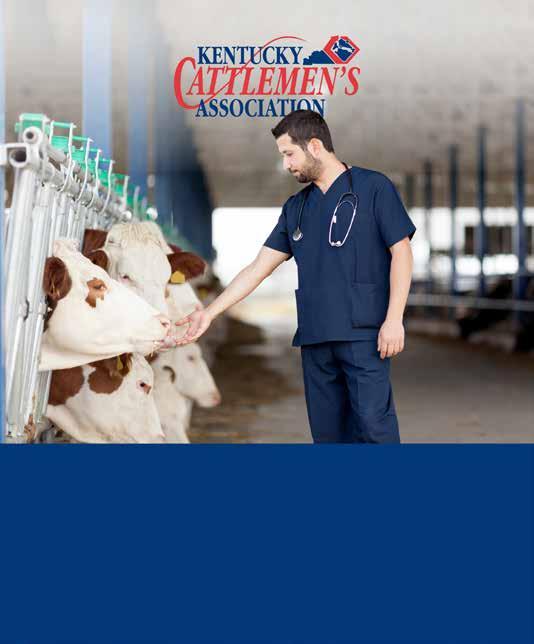
VETERINARY MEDICINE SCHOLARSHIP AVAILABLE to third or fourth year Kentucky student enrolled in a College of Veterinary Medicine. Apply at KYCATTLE.ORG by AUGUST 31, 2024 July • Cow Country • 27

Winter Grazing Requires Planning
Chris Teutsch UK Research and Education Center, Princeton
Hay is an important part of ruminant livestock systems in transition zone states like Kentucky. However, it tends to be an expensive feed source compared to winter grazing. The cost of producing a ton of grass hay can vary, but if you count fertilizer, machinery and a little labor, it will likely be more than $100 per ton (Table 1). The other challenge is producing hay that has high enough forage quality to meet the nutritional needs of lactating brood cows and even dry cows in some cases. On top of this, feeding that hay during the cold, wet and muddy winter months is not fun, especially if you work off the farm since it is dark when you leave and when you get home.
In contrast to hay, allowing animals to graze during the winter can significantly reduce winter feed costs. Extended grazing requires careful planning and timely implementation of practices designed to provide forage during the winter. Practices include stockpiling cool-season grasses and planting winter annuals. This article will discuss these options.
Economics of Extended Grazing
I want to start this section with the following disclaimer: I am a forage
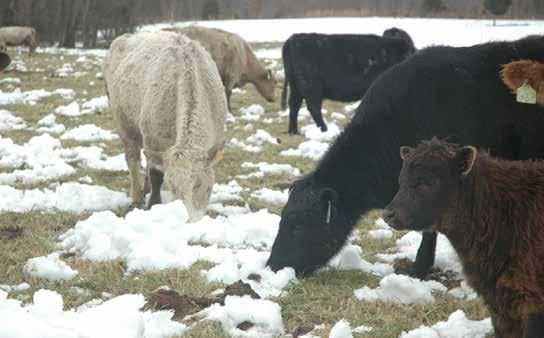
agronomist and NOT an economist. Even so, costs in ruminant livestock production systems have always been important to me. The following calculations are meant to provide you with a relative comparison of hay feeding versus grazing stockpiled grass. Costs can vary from farm to farm. So, it is important that you sharpen your pencil and do a little figuring for your operation.
Cost of Feeding Hay Assumptions:
• Hay cost is $110/ton
• Cost of feeding the hay is $20/ton
• Total cost of hay feeding is $130/ ton
• Storage and feeding losses are 20%
• Cows will eat 30 lbs. hay/day/cow
• Hay will need to be supplemented with corn gluten feed at a cost of $0.75/day
Feeding days per ton = 2,000 lbs./
ton of Hay - feeding losses in lb./ton of hay / 30 lbs. hay/day/cow = 2,000 lbs./ton - 400 lbs./ton / 30 lbs. hay/ day/cow = 53 feeding days/ton
Total cost of feeding hay = Hay costs per ton / feeding days per ton + supplement cost per cow per day = $130/ton hay / 53 + 0.75/day = $3.20/day/cow
Cost of Stockpiling
Assumptions:
• Stockpile yield of 2,500 lbs. DM/A
• Cost of stockpile tall fescue of $60/A
28 • Cow Country • July
Brood cow grazing stockpiled tall fescue in February.
ITEM UNITS COST COST Units/A $/unit $/A VARIABLE COSTS Nitrogen 80 0.55 $44 Phosphorus 60 0.60 $36 Potassium 120 0.40 $48 Lime 0.5 25.00 $13 Fuel/Oil 1 35.00 $35 Repairs 1 15.00 $15 Custom application 1 8.00 $8 FIXED COSTS Interest 1 20.00 $20 Depreciation 1 80.00 $80 Land Rent 1 35.00 $35 Labor 3 20.00 $60 Total Costs ($/A) $393 Total Costs @ 3.5 ton/A ($/ton) $112
Table 1: Cost of producing grass hay.
• 60 lbs. N/A + application cost about $40/A
• $20/A feeding cost (labor and temporary fencing)
• Utilization rate of 70% (strip grazing, moving fence twice per week)
Grazing days per acre = (2,500 lbs.
DM/A x 70% utilization) / 27 lbs. DM/ day/cow= 65 grazing days/A
Cost per grazing day = $60 / 65 grazing days/A = $0.92/grazing day
Difference Between Hay and Stockpiling
Cost of hay feeding – Cost of Stockpiling = $3.20/day/cow - $1/ day/cow = $2.20/day/cow
The bottomline is that stockpiling costs about one-third as much as feeding hay! For a 50-cow herd, that is a savings of approximately $110/day!
Cost of Winter Annuals
Assumptions:
• Winter annual yield of 5,000 lbs. DM/A
• Winter annual production cost of $225/A
• Annual ryegrass at 25 lbs./A
• 80 lbs. N/A, applied as a split application
• Utilization rate of 60% (strip grazing moving fence twice per week)
Grazing days per acre = (5,000 lbs. DM/A x 60% utilization) / 27 lbs. DM/ day/cow= 110 grazing days/A
Cost per grazing day = $225 / 110 grazing days/A = $2.04/grazing day
Difference Between Hay and Winter Annuals
Cost of hay feeding – Cost of Winter Annual = $3.20/day/cow - $2/day/ cow = $1.20/day/cow
The bottomline is that winter annuals cost about two-thirds as much as feeding hay! For a 50-cow herd, that a savings of approximately $55/day!
Tips for Stockpiling Perennial Grasses
Stockpiling is simply allowing forage growth to accumulate during one part of the year and using that growth for deferred grazing at a later date. In transition zone states like Kentucky, cool-season pasture growth is commonly stockpiled in late summer to extend grazing during the winter. Tall fescue is by far the best adapted grass for stockpiling. Tall fescue stockpiled for winter grazing is almost always higher in nutritional value than most of the hay made in Kentucky and will, in most cases, meet the requirements of a fall calving cow during peak lactation. In addition, grazing stockpiled grass costs about half as much as feeding hay that is supplemented. The following steps will help to optimize your stockpiling program.
Stockpiled tall fescue maintains its quality further into winter compared to other cool-season grasses.
Choose a strong tall fescue sod in a well-drained field. To get the
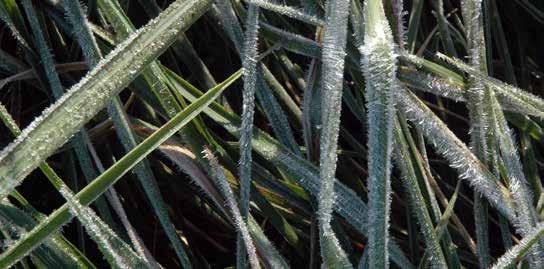
maximum yield response to nitrogen applications, you will need a healthy stand of tall fescue. Choosing a field that is well-drained will help to ensure that the stockpile can be grazed with minimal pugging damage during the wet winter months.
Clip pastures that will be stockpiled to 3-4 inches prior to applying nitrogen. Clipping pastures removes old growth and increases the forage quality of the stockpiled grass.
Apply 60-80 lbs. of nitrogen per acre in mid-August to early-September. Applying nitrogen too early can stimulate warm-season grass growth in pastures, while applying nitrogen too late decreases dry matter yield. When applying nitrogen in early to mid-September, decrease application rates to 60 lbs./A.
Allow growth to accumulate until midDecember before grazing. If limited grazing is available, feed hay during late summer and fall to allow pastures to stockpile.
Graze stockpiled pastures that contain legumes first. Legumes deteriorate faster than grass and should be grazed first to minimize losses.
Strip graze tall fescue to maximize grazing days. Ideally, allocating only enough stockpiled grass for two to three days will increase grazing days per acre by 30 to 40%. However, if you work off the farm, it may make more sense to allocate seven days of grass. This would allow you to move fences on your days off.
Frost seed legumes on grazed areas. Closely grazed stockpile provides an excellent opportunity to establish legumes in grass-dominated pastures. Broadcasting the seed as the pasture is being grazed can enhance soil-seed contact and increase overseeding success.
Tips for Utilizing Cool-Season Annual Grasses
Cool-season annual forages that can be used for winter and early spring grazing include small grains and annual ryegrass. Winter annuals can fill certain niches within grazing systems. For example, they could
July • Cow Country • 29
CONTINUED ON PAGE 30
Stockpiled tall fescue maintains its quality further into winter compared to other cool-season grasses.
be used to thicken thin cool-season pastures, grown in a rotation with a summer annual forage, used to overseed a warm-season perennial forages such as bermudagrass, or used in a renovation sequence. The following tips will help you optimize cool-season annual use in your grazing system.
Planting date. Cool-season annuals can be seeded from mid-August to mid-September. If fall grazing is desired, they must be planted by early September. Later plantings will provide little grazing in the fall and winter.
Suppress existing sod. Suppressing competition from an existing sod or summer annual crop will help to ensure that you get a uniform stand. Ideally, pastures to be overseeded should be grazed closely and sprayed with a nonselective herbicide just before planting.
Planting method. Winter annuals can be planted on a conventional seedbed or no-till seeded. No-till seedings tend to support winter grazing better than conventional seedings.
Seeding depth. Seeding depth should be 1-2 inches for small grains and 0.5 to 1 inch for annual ryegrass.
Seeding rates. Small grains seeded alone should be planted at a rate of 90-150 lbs./A. Annual ryegrass seeded alone should be planted at a rate of 25 lbs./A. A mixture of small grain and annual ryegrass should be seeded at a rate of 90 and 15 lbs./A, respectively. If fall grazing is desired, use the higher end of the seeding rates. Crimson clover can be added at a rate of 10 lbs./A.
Soil fertility. Apply phosphorus, potassium and lime according to soil test results. If fall grazing is desired, apply 40-60 lbs. nitrogen/A at seeding. An additional 40-50 lbs. N/A should be applied in early-March to stimulate spring growth. For annual ryegrass only, an additional 40-50 lbs. N can be applied in mid-April after the first grazing.
Grazing management. Ideally, winter annuals should be rotationally stocked. Grazing can begin once the seedlings are well anchored and

have reached a height of 8-10 inches. Grazing should be stopped when a residual height of 3-4 inches has been reached.
Bottomline
In Kentucky, our competitive advantage for winter grazing is tall fescue. Stockpiled tall fescue is the cheapest option for winter grazing and provides exceptional forage quality,
FEATURED UPCOMING EVENT
especially in early- to mid-winter. Winter annuals can also be used to extend grazing, but the cost is more than twice that of stockpiled grass. We will always need some hay, but we should work to reduce our hay feeding period to around 60 days!
For more information on stockpiling and winter grazing, please contact your local Cooperative Extension office.
Heart of America Grazing Conference…Regenerative Grazing Hardin County Extension Office • Oct 15-Pasture Ecology Workshop at Glenmar Farms, Cecilia • Oct 16-Main Conference, Elizabethtown • Oct 17-Regenerative Pasture Walk at Big Spring Farm, Adolphus • More information at https://forages.ca.uky.edu/events
FEATURED PUBLICATION
This month’s featured publication is: Stockpiling for Winter Grazing by Garry Lacefield, Ray Smith, Jimmy Henning, John Johns and Roy Burris. You can access it at https://tinyurl.com/ mtm7pvce or by visiting your local extension office.
FORAGE MANAGEMENT TIPS
• Graze summer annuals pastures and fertilize with 40-60 lbs. N/A if regrowth is desired.
• Identify pastures to stockpile for winter grazing. Pastures should be well drained and have a strong sod. Limit summer grazing so that they are ready to grow as conditions cool and rain comes in late summer.
• Do NOT mow hayfields or graze pastures closer than 4-5 inches.
• Soil test pastures to determine nutrient needs.
• Use UK variety testing results to select varieties to plant in the fall.
• If drought occurs, confine animals to one pasture and feed hay.
Annual ryegrass produces extremely high-quality forage for winter and spring grazing.
CONTINUED FROM PAGE 29
WHO IS RESPONSIBLE FOR REMITTING THE CHECKOFF ASSESSMENT?
BUYER
Generally the Buyer is responsible for collecting the Beef Checkoff assessment from the Seller
SELLER
50¢

QUALIFIED STATE BEEF COUNCIL
However, both the Buyer and the Seller are responsible for seeing that the Checkoff is collected and paid. or pays $2 to $1.50
Cattlemen’s Beef Board invests in national Checkoff programs, while Kentucky Beef Council invests in state programs.
If you are a producer from one of these seven states - Alaska, Connecticut, Maine, Maryland, Massachusetts, New Hampshire, and Rhode Island - you will remit directly to the Cattlemen’s Beef Board. If you have any questions regarding who is responsible for remitting the Checkoff assessment or how to remit payment, please contact your State Beef Council or the Cattlemen’s Beef Board at (303) 867-6304.
3 Exceptions to Beef Checkoff Collection: 1. Non-producer status: If a person (or company) owns cattle for 10 days or less, purchases the cattle to facilitate the transfer of ownership to a third party, and certifies that any Checkoff dollars due from the previous owner have been collected, then that person qualifies as a “Non-Producer” and the Checkoff assessment is not due when qualified cattle are resold. 2. Organic Exemption: In the 2002 Farm Bill, Congress created a process exemptiing organic producers from paying Checkoff program assessments. 3. Pre-Payment: Producers can also choose to “prepay” the Checkoff assessment when shipping cattle out of state for feeding and still retain ownership on the cattle. This allows the producer to direct half of the $1-per-head national Checkoff assessment to the beef council in the state where the cattle were raised, rather than the state where the cattle will be fed. Note: To claim any of these exemptions, the person selling the cattle must provide the proper ‘document’ to show that the Checkoff assessment is not due at the time of sale. Thus, the rule of thumb for all cattle sales is that the person paying the producer should collect either a “Dollar or a Document.”
LIVESTOCK MARKET - When cattle are sold through a livestock market or video market, the Market collects and remits the Beef Checkoff assessment.
CATTLE DEALER/ORDER BUYER - When cattle are sold to a Cattle Dealer or Order Buyer, the Dealer/Order Buyer collects and remits the Beef Checkoff assessment.
ANOTHER PRODUCER - Both the Buyer and the Seller are responsible for making sure that the Beef Checkoff assessment is collected and remitted. For clarity and consistency, we encourage the Seller to take on this compliance responsibility.
VEAL GROWER - When dairy calves are sold to a Veal Grower, both the Buyer and the Seller are responsible for making sure that the Beef Checkoff assessment is collected and remitted. For clarity and consistency, we encourage the Seller to take on this compliance responsibility.
CATTLE SHOWS AND FAIRS - When producers sell their animals at fairs or cattle shows (4H/FFA shows, Purebred cattle shows, etc.), the Organization that runs the sale collects and remits the Beef Checkoff assessment.
FEEDLOT - When cattle are sold directy to a feedlot, the Feedlot collects and remits the Beef Checkoff assessment.
PACKING PLANT - When cattle are sold to a packing plant, the Packing Plant collects and remits the Beef Checkoff assessment.
DIRECT-TO-CONSUMER BEEF SALES - When producers market their cattle as beef, the Producer is responsible for remitting the Beef Checkoff assessment.
The U.S. Department of Agriculture (USDA) prohibits discrimination in all its programs and activities on the basis of race, color, national origin, age, disability, and where applicable, sex, marital status, familial status, parental status, religion, sexual orientation, genetic information, political beliefs, reprisal, or because all or part of an individual’s income is derived from any public assistance program. (Not all prohibited bases apply to all programs.) Persons with disabilities who require alternative means for communication of program information (Braille, large print, audiotape, etc.) should contact USDA’s TARGET Center at (202) 720-2600 (voice and
TODAY’S DATE ID NUMBER (IF KNOWN) SELLER’S NAME CITY SELLER’S SIGNATURE STATE ZIP Both the seller and the buyer are responsible for making sure that the $1 per head assessment is collected and remitted to the Kentucky Beef Council. $ $1.OO per Head Federal Checkoff $ $1.OO per Head State Checkoff X BUYER’S NAME ADDRESS ADDRESS CITY STATE ZIP BUYER’S SIGNATURE DATE OF SALE PERSON REMITTING FORM TOTAL NUMBER OF CATTLE SOLD + = $ Total Checkoff Payment for Federal and State BUYER SELLER PHONE STATE OF ORIGIN* *If the cattle purchased came from another state within the last 30 days, indicate from which state the cattle were purchased. X
1995,
agency may not conduct
sponsor, and a person is not required to respond
a collection of information unless it displays a valid OMB control number. The valid OMB control number for this information collection
0581-0093.
time required
complete this information collection
estimated
average one hour
response,
time
reviewing instructions, searching existing data
gathering
maintaining the data needed,
collection
information.
TDD).
file
to
Civil Rights, 1400 Independence Avenue, S.W., Washington, D.C. 20250-9410
call (800) 795-3272
(202) 720-6382 (TDD). USDA is an equal opportunity provider and employer. Send Report and Remittance to: Kentucky Beef Council 176 Pasadena Drive Lexington, KY 40503 For additional information: call 859-278-0899 or email beef@kycattle.org PRIVATE TREATY
State and National Beef Promotion and Research Programs Information is required by 7 CRF 1260.201. Failure to report can result in a fine. Information is held confidential per 7 CRF 1260.203.
THROUGHOUT THE CATTLE PRODUCTION
According to the Paperwork Reduction Act of
an
or
to
is
The
to
is
to
per
including the
for
sources,
and
and completing and reviewing the
of
To
a complaint of discrimination, write
USDA, Director, Office of
or
(voice) or
SALES CHECKOFF INVESTMENT FORM
BEEF CHECKOFF COLLECTION
CYCLE
July • Cow Country • 31
MEMBERSHIP
"I'm
 Isaac
Isaac
Thompson
Taylor County Cattlemen's Association
32 • Cow Country • July DIVISION 3 (UP TO 75 MEMBERS) 2024 2023 Diff Russell 78 65 13 Out of State 86 66 20 Campbell 65 74 -9 Woodford 63 64 -1 Grant 59 74 -15 Rockcastle 64 66 -2 Calloway 55 55 0 Taylor 52 59 -7 Oldham 55 61 -6 Estill 56 53 3 Mason 54 70 -16 Todd 68 58 10 Montgomery 54 54 0 Whitley 46 49 -3 Wayne 42 41 1 Simpson 43 41 2 Ohio 44 50 -6 McCreary 46 38 8 Carroll 51 45 6 Highlands 41 38 3 Hancock 35 36 -1 Union 35 63 -28 Nicholas 31 43 -12 Butler 29 35 -6 McLean 26 22 4 Clay 26 29 -3 Crittenden 23 26 -3 Hopkins 24 23 1 Livingston 22 17 5 Knox 21 30 -9 Bullitt 28 30 -2 Menifee 15 21 -6 Henderson 11 9 2 Gallatin 8 8 0 Magoffin 6 6 0 Powell 5 7 -2 Pike 5 5 0 Eastern Foothills 5 7 -2 Harlan 0 1 -1 Bell 0 0 0 If you need anything for membership, please contact Rachel Cain at (859) 278-0899 or rcain@kycattle.org 2024 2023 Difference Totals as of: June 10, 2024 10,744 11,114 -370
DIVISION 1 (151+ MEMBERS) 2024 2023 Diff Barren 402 482 -80 Shelby 358 378 -20 Marion 352 301 51 Adair 338 326 12 Christian 331 333 -2 Breckinridge 291 269 22 Bath 321 348 -27 Madison 303 307 -4 Lincoln 258 227 31 Hart 232 244 -12 Washington 230 221 9 Grayson 229 237 -8 Logan 221 206 15 Henry 214 192 22 Edmonson 180 204 -24 Franklin 180 167 13 Larue 175 157 18 Mercer 170 192 -22 Meade 175 167 8 Metcalfe 163 151 12 Northern Kentucky 161 168 -7 Bracken 197 188 9 Jessamine 170 218 -48 Casey 152 172 -20 Hardin 153 160 -7 Green 158 160 -2 Harrison 160 153 7 Clark 148 185 -37 Laurel 147 151 -4 Warren 141 159 -18 DIVISION 2 (76-150 MEMBERS) 2024 2023 Diff Fleming 122 127 -5 Scott 123 121 2 Monroe 124 128 -4 Garrard 118 109 9 Daviess 116 121 -5 Pulaski 110 146 -36 Trigg 115 104 11 Northeast Area 102 103 -1 Caldwell/Lyon 109 119 -10 Anderson 102 109 -7 Boyle 89 101 -12 Mountain 88 97 -9 Webster 84 79 5 Jackson 85 118 -33 Lewis 86 78 8 Trimble 87 110 -23 Owen 95 90 5 Pendleton 81 90 -9 Robertson 77 77 0 Purchase Area 81 83 -2 Muhlenberg 75 78 -3 Fayette 73 83 -10 Louisville Area 70 75 -5 Bourbon 71 97 -26 Clinton-Cumberland 58 63 -5 Nelson 69 76 -7 Allen 109 112 -3 Twin Lakes 38 58 -20
a member because of the advocacy the association does for me."
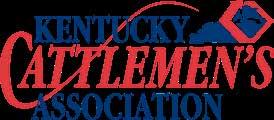
2023-24 MEMBERSHIP APPLICATION
* MEMBERSHIP YEAR 10/1/23– 9/30/24
NAME SPOUSE NAME FARM NAME
*Payments of KCA membership dues are tax deductible for most members as an ordinary and necessary business expense. However, charitable contributions of gifts to KCA are not tax deductible for Federal Income Tax purposes. Due to new IRS regulations, $2.24 of your dues would not be deductible. Approximately $12 of your dues will go towards the monthly publication Cow Country.
PLEASE CHECK THE MEMBERSHIP(S) YOU WOULD LIKE TO JOIN:
KCA MEMBERSHIP ($30/YR) NEW RENEWAL
Membership dues are $30 unless otherwise listed below
KCA COUPLE MEMBERSHIP
To add your spouse, please add $15 to your KCA Membership
KENTUCKY JUNIOR CATTLEMEN’S ASSOCIATION ($10/YR) NEW RENEWAL
I WOULD LIKE ADDITIONAL INFORMATION ON THE YOUNG PRODUCER’S COUNCIL
TOTAL MEMBERSHIP:
$ KCA
$ KJCA
TOTAL CONTRIBUTIONS:
$ CATTLEMEN’S FOUNDATION DONATION (voluntary)
TOTAL AMOUNT ENCLOSED:
$ ALL DONATIONS TO KCF ARE TAX DEDUCTIBLE
COUNTY DUES
Dues are $30 except for the counties listed below.
Allen...............................$40
Anderson........................$25
Bourbon.........................$20
Boyle ..............................$35
Bullitt..............................$20
Butler..............................$25 Franklin ..........................$25
Highlands .......................$20
(Boyd, Floyd, Johnson, Lawrence, & Martin)
..........................$35 Laurel.............................$35 Louisville Area ................$20 (Jefferson, & Spencer) Magoffin .........................$20 Menifee ..........................$25
Mountain........................$25
(Breathitt, Knott, Lee, Leslie, Letcher, Morgan, Owsley, Perry & Wolfe)
Woodford......................$25
IF YOU WOULD ALSO LIKE TO JOIN THE NATIONAL CATTLEMEN’S BEEF ASSOCIATION The NCBA is now a State Marketing Partner with the KCA. You can pay your dues to both organizations with one check, at the same time.
ADDRESS CITY COUNTY STATE ZIP RECRUITED BY PHONE FAX EMAIL
Hopkins
Oldham ..........................$35 Taylor..............................$20 Twin Lakes ......................$20 Warren ...........................$40 Wayne ............................$25 Whitley
...........................$25
1-100 # HEAD DUES $160 101-250 $320 251-500 $480 501-750 $693 751-1000 $960 1,001-1,250 $1,227 1,251-1,500 $1,493 1,501-1,750 $1,760 1,751-2,000
Kentucky Cattlemen’s Association 176 Pasadena Drive • Suite 4 • Lexington, KY 40503
online at www.kycattle.org or call (859) 278-0899 July • Cow Country • 33
$2,027 > 2,000 $2,027 + $0.4053/HD # HEAD DUES Complete and return to:
Join
 Bradon Burks Director of Education
Bradon Burks Director of Education
In early June, Kentucky FFA celebrated their 95th state convention. The convention featured a range of competitions, spanning from public speaking to team sales, providing a platform for future agriculturalists to showcase their talents and skills. The Kentucky Beef Council’s presence at this year's convention was met with enthusiasm, as we were set up in the trade show giving out around 1,400 Beef It’s What’s For Dinner T-Shirts for FFA members and agricultural teachers. To get a shirt, participants had to share why they advocate for the beef industry on social media. We were overwhelmed with the amount of publicity and engagements those social posts made. It’s always great getting to see the next generation of beef advocates sharing their stories.
Speaking of beef advocates, 38 passionate young people took part in the signing of the "Kentucky Beef Council’s Young Beef Advocate Proclamation." This ceremony honored these youth for their dedication to becoming the next generation of Kentucky beef industry advocates. Signing alongside these advocates were KCA Executive Vice President Dave Maples and NCBA’s Director of Grassroots Advocacy and Spokesperson Development Chandler Mulvaney. In signing the proclamation, participants affirmed their commitment to advocating for beef, pledging to share not only their personal experiences, but also the stories of Kentucky’s 32,000 beef farm families. Recognizing the growing demand for beef in today's market, they expressed their determination to play a leading role in raising awareness for the industry. Alongside their signed and framed proclamations, participants received comprehensive resources to equip them with the tools and knowledge to effectively communicate their "beef story" and use factual information in conversations with consumers who may be uninformed about the industry.
The following week, KBC teamed up with UK’s agricultural education and meat science groups to host 16 agriculture teachers and master’s students in our first-ever “Gate to Plate” educational professional development. This three-day program was packed with content on how we truly get our beef from gate to plate. Attendees went to Eden Shale farm for a tour with Dan Miller and Steve Higgins. I always appreciate getting to take groups

2024 Signees

Addison Woodall Todd County Central
AdyMae Williams Hardin County
Anna Bennett Henderson County
Brady Vinson Lawrence County
Brooklynne Perry Central Hardin
Callie Derossett Henry County
Camdon Mitchell Anderson County
Cheyanne Rodgers Christian County
Creighton Smith Horizons FFA
Cyrus Bivens LaRue County
Gavin Kudrna LaRue County
Grace Hylton Lawrence County
Jackson Kidd Elliott County
Jacob Marksbury LaRue County
Jennie Watts Trigg County
Katie Beth Meals Central Hardin
Kelsey Vance Lawrence County
Klaber Wolfe Pendleton County
to Eden Shale, because I know they will get to see how technology and innovation is being used to help expand our industry. The group also got to be in the cutting room at UK’s Meats Lab. If you have never had the privilege of sitting through a demo from Gregg Rentfrow and Brock Billingsley, you are definitely missing out. They do a fantastic job of sharing how we get from primal regions to retail cuts. The group also got to participate in a Build
Layla Even Anderson County
Lillian Darr Muhlenberg County
Lily Jeffries Hart County
Logan Minter Central Hardin
Lucy Jeffries Hart County
Maddox Coffman LaRue County
Mattie Gardner Hart County
McKenna Jackson Horizons FFA
Miguel Salazar LaRue County
Mireya Villanos LaRue County
Parker Keyes Gallatin County
Renesamee Huff LaRue County
Sayde Lowe Calloway County
Saydee Cowan Webster County
Sophia Smith Horizons FFA
Ty Jones Allen County-Scottsville FFA
Tyler Hutchinson Pendleton County
Will Beckley Estill County
a Burger Culinary Contest, and a Create your Best Steak Rub Challenge. These activities were two shining examples of not only beef’s versatility on a plate, but how these teachers can utilize our protein within their classes.
The final day was led by Chef Mike Erickson, president of the National High School BBQ Association and Lyda Garcia, meat specialist with The Ohio State University. They focused on how
34 • Cow Country • July
Adam McCauley Harrison County
Landon Miller Nelson County
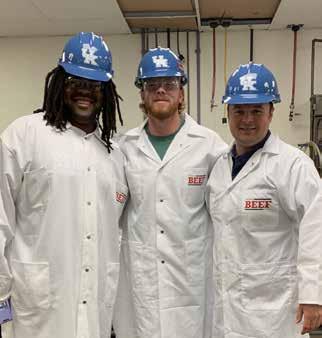
we can use innovative cooking methods to prepare various beef cuts. One of the attendees this week was Ricky Lumpkin, current UK graduate student and former NFL defensive lineman for the Arizona Cardinals, Las Vegas Raiders and Indianapolis Colts.
When asked about his experience during the program he said, “This has been an informative and fun week. Learning and seeing how our beef is handled and cared for has been insightful. How the carcass is broken down, and nothing goes to waste is impressive. I have always appreciated our farmers and butchers, but this made me care and appreciate them even more, as they are underappreciated overall.”
Brock Vandagriff, UK quarterback and graduate student in Community and Leadership Development, said the experience was all encompassing.
“The Beef PD was an excellent couple of days,” Vandagriff said. “It was really awesome to see exactly how our beef goes from ‘gate to plate.’ The coolest part to me was being able to have a true boots on the ground experience being able to walk around and see exactly how our beef gets on our plate. We didn’t skip any steps!”
I truly believe that programs like this are a wise investment of our Checkoff, and the collaborative approach ultimately expands the reach of all the parties involved. I want to say a big “Thank You” to UK’s Rebekah Epps, Gregg Rentfrow, and their entire support team. I truly feel like we were able to offer an engaging immersive program that will create a ripple effect from our next teachers to their students, and then on to their parents. It is my hope that our producers can see the impact their investments are making in growing demand in the beef industry.
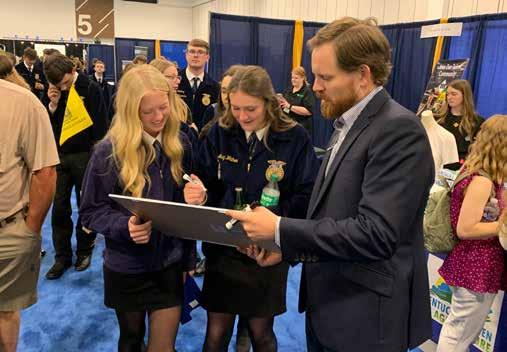
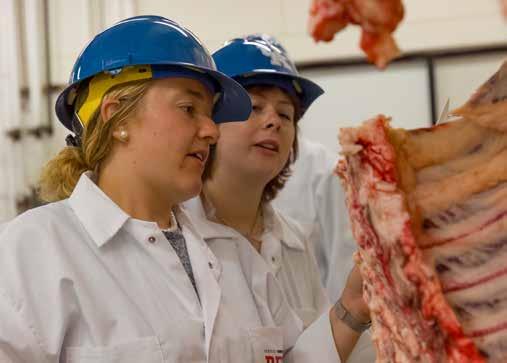
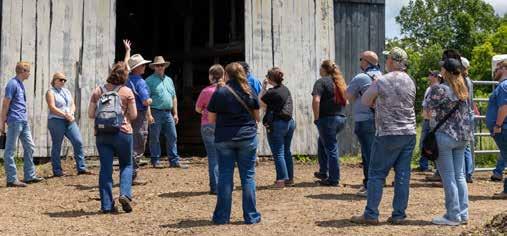

July • Cow Country • 35

Adding Value To Your Marketing Plan
Jake Harrod Program Coordinator, Kentucky Beef Network
As I am writing this, we just finished the last of the Spring value-added sales that we at the Kentucky Beef Network help support. These sales include the Kentucky Certified Hereford Influence Sale, the Charolais Influenced Feeder Calf Alliance Sale and the Profit Thru Performance Feeder Calf Sale. To put your calves into a sale like this is a great opportunity to help add more value to your calf crop and increase your sale profits.
Reading this, you may wonder what “value-added” means. Valueadded applies to ways a producer markets their cattle to make them stand out from other animals. There are numerous ways to go about adding more value to calves that you intend to sale. This can include incorporating basic management practices like weaning, castration and testing for BVD. That is exactly what the sales mentioned above are doing. They have created an outline of basic management processes that consignors must follow to have their cattle qualify for these sales. These practices help cattle in these sales standout from others as it reduces the workload the buyer has to do to get these animals to the next step on their journey. Thus, sellers are rewarded for their additional work. It also creates an opportunity for producers to combine their like cattle and sell them as load lots, which also increases your profits.
The sales mentioned above use a mix of practices that help increase the return on the investment on the animals sold. With some planning and effort, most producers can easily incorporate some of these things into their livestock development

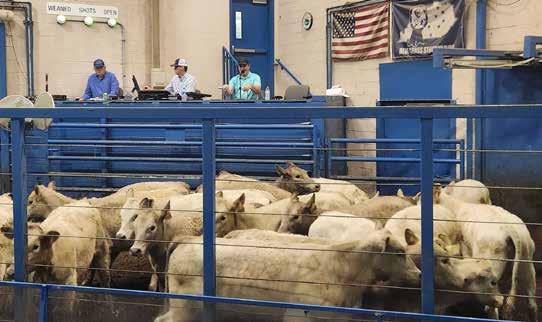
program and capture those additional returns. To start, these sales have a set vaccination and worming protocol in place. This protocol can include vaccinating for things such as IBR, BVD and blackleg. Some other great management practices include castrating your bull calves and weaning all calves before sale time. Castrating your bull calves can instantly add more value to the calf in question. It can be incorporated into to the management protocols you are already doing on your operation. However, it may mean adjusting your cattle working schedule to catch the calf when it is still young or you may choose to castrate when you get all of your animals up to work them. Weaning your calves before the sale helps them have time to adjust to being away from their mother, which keeps them calmer at the sale barn. It also keeps them in better health with less chances of getting sick when they are sold. Another value-added
practice is to work with your local veterinarian to pregnancy check the heifer calves you intend to sale. You can gain additional value by guaranteeing that those heifers are open.
Overall, using these “value-added” practices can help to create more profitable marketing opportunities. When you do any of these practices, be sure that potential buyers know about them prior to the sale by including it in any description of the animals, making a note of it when you arrive at the stockyards or by placing your calves in a value-added sale with other producers. Remember you cannot be rewarded for extra work if the buyers don’t know about it.

Have you participated in a Kentucky Beef Network or UK Beef Extension Team Program? Please scan here to provide feedback.
805-0724 jacob.settles4@yahoo.com
36 • Cow Country • July
Settles
Ben Lloyd Whitesville, KY (270) 993-1074 benlloyd0223@gmail.com Charles Embry Cave City, KY (270) 646-5939 dale.embry@yahoo.com Jacob
Springfield, KY (859)
Ron Shrout Winchester, KY (606) 205-6143 ronshrout@bellsouth.net
FIELD
KENTUCKY BEEF NETWORK
ASSOCIATES
Charolais Influenced Feeder Calf Alliance, Blue Grass South Stanford KY

Eden Shale Update
Dan Miller Industry Coordinator, Kentucky Beef Network
May continued to be busy managing the cow herd through the synchronization process to get everything ready to AI. We had 18 replacement heifers and 88 cows that were artificially inseminated this year. The replacement heifers were pelvic measured the end of April. Then CIDRs went in on May 16. The heifers followed a five-day synchronization protocol, and the CIDRs came out on May 21. Les Anderson with the University of Kentucky bred the heifers on the morning of May 24. The heifers were sorted into two groups, one getting bred to Angus (MVP) and the other to Hereford (Small Town Kid). The heifers will get cleaned up with an Angus bull. The cows followed the seven-day synchronization protocol. Their CIDRs went in on May 21 and were pulled on May 28. The 88 cows were bred on May 31 by David McGlothlin with Genetics Plus. The cows were also sorted into two groups −one got bred to Angus (Plus One) and the other to Hereford (Kingdom). The cows will also get cleaned up with Angus bulls. The cleanup bulls got turned in on June 6.
On May 21, the day we pulled the heifers’ CIDRs and inserted the cows’

CIDRs, we also collected genetic tissue samples on all of the cows and heifers. We are doing this as a trial to see what information we get back and if it is helpful for a commercial operation. We collected samples for both the Zoetis and Neogen tests, so that we can compare the results and see if either is more beneficial than the other. It will be July before we have the results, and I will provide updates as we learn more about our herd.
I did have lots of help lined up that day to assist with all the work. Greg, of course, kept the cattle flowing to us, and my kids were out of school

that day keeping the tub and alley full of cows ready to enter the chute. From the office, we had Dave putting CIDRs in, Jake collecting the Zoetis tissue samples, Becky collecting the Neogen tissue samples, Alex keeping the records, I ran the chute and gave the pinkeye vaccine and put in fly tags, and Danny recorded all the action from various locations. It was a big day, and everything went smoothly. I want to say thank you to my coworkers for all the help. I am thankful to work with people who share my passion and knowledge of animal agriculture.
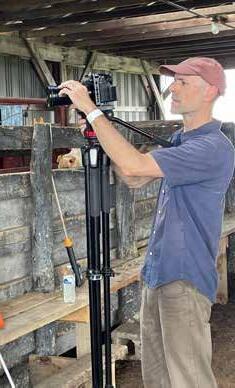
June • Cow Country • 37
SANTA GERTRUDIS DATA DRIVEN • PROFIT PROVEN
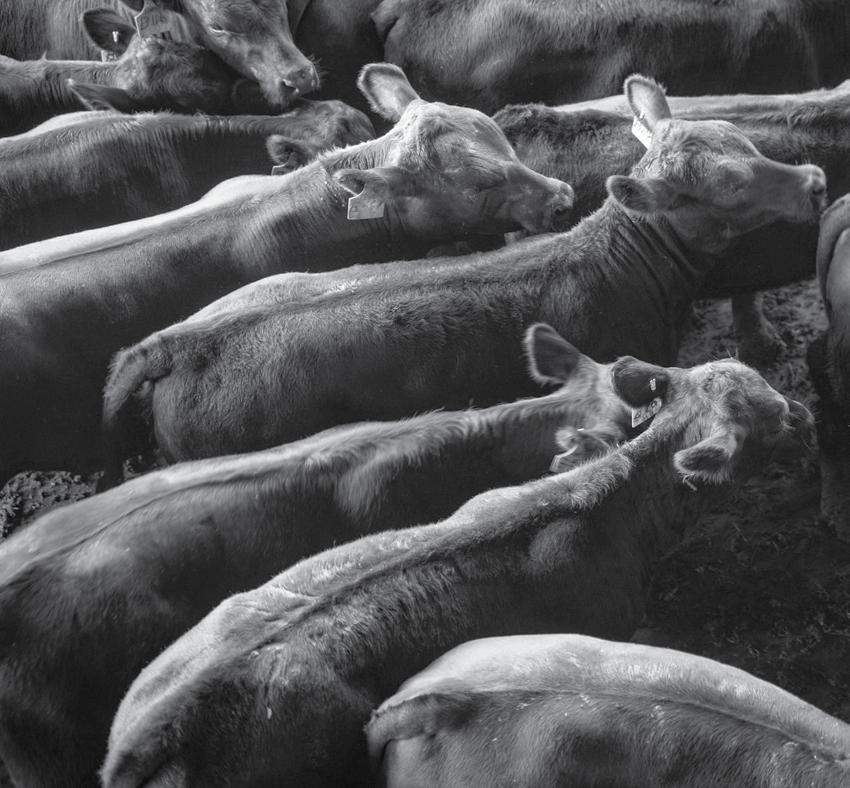

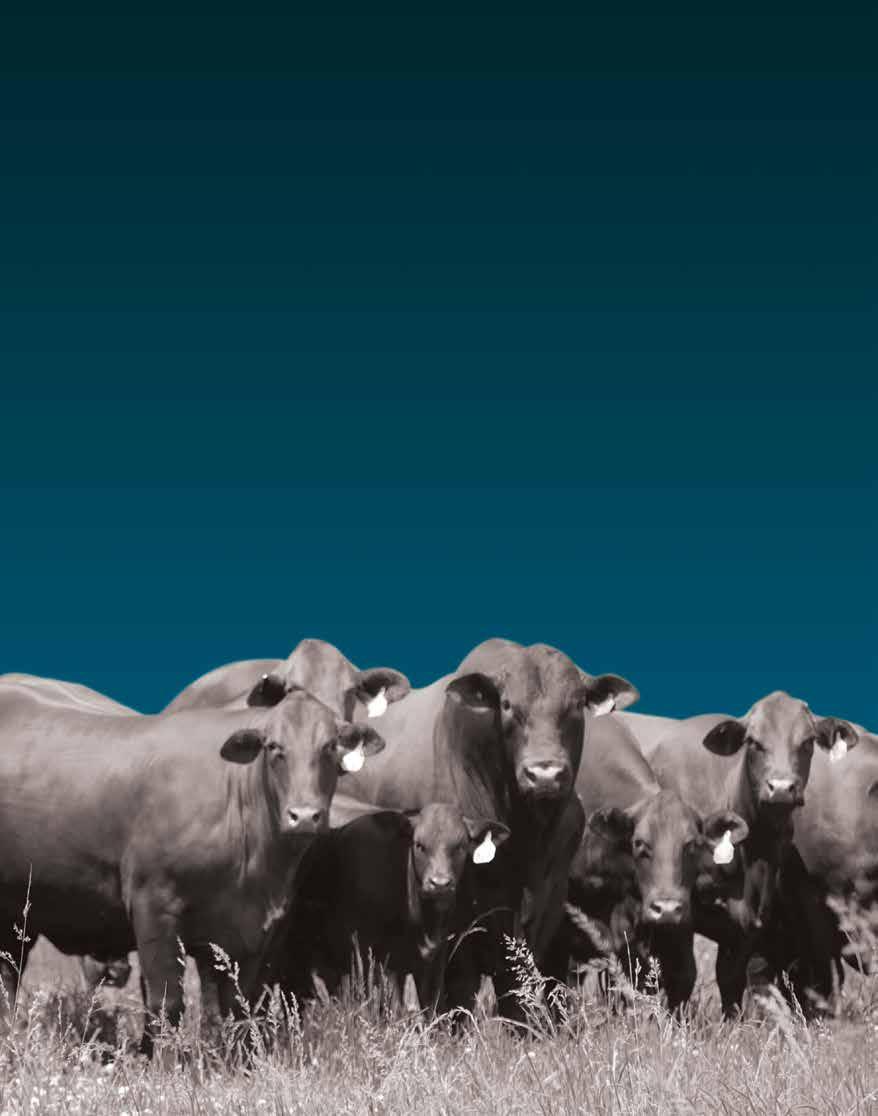
Pat & Beverly Heath • Heath Farms 387 Goodin-Williams Rd. • Hodgenville, KY 42748 270/358-4820 Randall & Barb Beckman • Beckman Farms 2899 Memory Lane • Lanesville, IN 47136 812/952-2190 Mattingly Farms 488 Rock Haven Road • Brandenburg, KY 40108 270/668-3177 John, Karen, Nolan and Emily Taylor Windcrest Farms 1238 Claggett Road Leitchfield, KY 42754 270/287/8629 Jewett Borden III • Cedar Creek Farm 696 Cundiff Lane • Shepherdsville, KY 40165 502/718-5441 The Smith Family Rebel Ridge Santa Gertrudis 1510 Rebel Ridge Road • LaGrange, KY 40031 • 502/579-1959 Charles and Deanna Parker • Parker Farms 5552 Jackson Highway • Cave City, KY 42127 270/670-6776
46th ANNUAL SALE • JULY 19-20 • BOWLING GREEN, KY United Producers Livestock Market Arrow Creek Santa Gertrudis M. C. Longacre, Jr. Old Cedar Point Farm • Elizabethtown, KY • 270/505-2910 Todd Osborne Mosby Creek/Osborne Livestock Sparta, Kentucky • 859/991-2438

SIMMENTAL
KEVIN AND RACHEL BARRON
Crestwood, Ky
(502) 905-5851
rkbarron812@gmail.com
SWAIN SELECT SIMMENTAL 12113 Green Valley Dr. Louisville, KY 40243


swainselect.com swainselect@gmail.com facebook.com/swainselectsimmental
Fred & Phyllis: 502-599-4560 Chi & Angie: 502-287-2116

JUDY AND RONDAL DAWSON 1156 Buzzard Roost Road Shelbyville, KY 40065 502-593-5136 • jrdawson22@outlook.com

JEROD METZGER • 270-779-6260

ROCKING P LIVESTOCK 8308 Orangeburg Road Maysville, KY 41056
Chan: 606-584-7581
Keith: 606-584-5626
rockingplivestock@maysvilleky.net
BRIAN & HEATHER SWAIN 3906 Pottertown Road Murray, KY 42071 • 270-293-4440
wksbswain@murray-ky.net


SIMMENTAL AND SIMANGUS BULLS FOR SALE
1939 Huntertown Road
Versailles, KY 40383
BULLS FOR SALE
Chris Allen 859-351-4486 callenuky@hotmail.com
Dr. Henry Allen 859-229-0755


Simmental calves are champions of the scale.
They reliably outperform straightbred calves in the feedyard — with better growth, better structure and fewer health problems.
They add pounds without sacrificing marbling, and they come with the IGS Feeder Profit Calculator,™ which factors genetics, health and management into true value.
Want low-risk, high-potential calves with earning capability?
406-587-4531 • simmental.org

BRET AND LAURA JACKSON 859.533.3718 or 859.707.7200
BRET & LAURA JACKSON Paris, Kentucky (859) 533-3718 (859) 707-7200
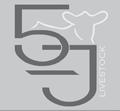
STAND STRONG SIMMENTAL
NO LIGHTWEIGHTS JOIN KENTUCKY SIMMENTAL ASSOCIATION Mail to: Laura Jackson 1254 Cynthiana Road Paris, KY 40361 FARM NAME YOUR NAME ADRESS CITY, STATE ZIP WORK PHONE HOME PHONE Call or visit one of these Simmental breeders for cattle that work! www.kysimmental.com Membership Fee is $25.00
BOYD BEEF CATTLE
6077 Helena Road
Mayslick, KY 41055
Charlie Boyd II: (606) 584-5194
Blake Boyd: (606) 375-3718 www.boydbeef.com cboyd2@maysvilleky.net
BURTON & SONS ANGUS
Joe D. or Karen Burton
ANGUS
THE BUSINESS BREED


480 Hominy Hill Rd. Nancy, KY 42544
Joe: (606) 305-3081
Located 15 miles West of Somerset • klburton01@windstream.net
Bulls & females sold private treaty. Inquiries Welcome. Sell only what we would buy. Data driven since 1981.
FALL CREEK ANGUS
448 Corder Farm Road
Monticello, KY 42633
Ronnie Corder (606) 348-6588
HILL VIEW FARMS
Jimmy Gilles
5160 Lee Rudy Road Owensboro, KY 42301 (270) 929-5370 jcgilles86@gmail.com
OLD BARK FARM
370 Ferrill Hill, Buffalo, KY 42716
Kenley Conner (502) 905-7825
Registered Angus Cattle
ST. CLAIR FARMS REGISTERED ANGUS
Eric & Sherry St. Clair
13433 Falls of Rough Road Falls of Rough, KY 40119
Home: (270) 257-2965 • Cell: (270) 617-1079 www.stclairangus.com
Performance Tested Bull & Female Sale April 2020

TWIN CREEK FARM
Shawn, Melissa, Devin & Dylan Gibson (270) 337-3072 or (270) 692-5304 Dennis & Emily 270/337-2128 or 270/402-4338
Jimmy Gilles 5160 Lee Rudy Road Owensboro, KY 42301 (270) 929-5370 jcgilles86@gmail.com

927 Old Liberty Pike • Hustonville, KY 40437 (859) 238-0771 • www.branchviewangus.com
James S. & LuAnn Coffey, Donald & Donna Coffey Annual Production Sale- 2nd Saturday in April
Saturday in April
COFFEY ANGUS FARMS
661 Hopewell Road Liberty, KY 42539
Burks • (270) 991-6398 www.burkscattle.com
Matt Coffey: (270) 799-6288
Dewey Coffey: (606) 706-2699
BURTON & SONS ANGUS
Genetics for Maximum Profitability since 1984
Joe D. or Karen Burton
480 Hominy Hill Rd. Nancy, KY 42544
Joe: (606) 305-3081
GREAT MEADOWS ANGUS ASSOCIATION

Vice
Secretary/Treasurer:
BURKS CATTLE CO. 531 Rick Rd. Park City, KY 42160
JOHNSON FARMS ANGUS


Located 15 miles West of Somerset • klburton01@windstream.net Bulls & females sold private treaty. Inquiries Welcome. Sell only what we would buy. Data driven since 1981.
COFFEY ANGUS FARMS
661 Hopewell Road Liberty, KY 42539
Dale Brown, President 292 Pea Ridge Road Stamping Ground, KY 40439 859-940-8437 www.greatmeadowsangus.com
Matt Coffey: (270) 799-6288
Dewey Coffey: (606) 706-2699

Genetics for Maximum Profitability since 1984
DAVIS BEND FARMS
LYNN CREEK FARMS
2315 Davis Bend Road Canmer, KY 42722
Kris and Sara Lynn 2184 Bardstown Rd Springfield KY 40069 573-721-6663
timmothyljeffries@gmail.com www.davisbendfarms.com Tim: (270) 528-6605 • Leslie: (270) 528-6435

FALL CREEK ANGUS
APS ANGUS
448 Corder Farm Road Monticello, KY 42633
Ronnie Corder (606) 348-6588
4040 Taylorsville Rd Taylorsville, KY 40071
Gordon Schubert
502-477-2637 • 502-548-8440
ANGUS FARMS

Anne Patton Schubert 502-477-2663 • 502-548-2359
Eddie Hamilton 2142 Stilesville Road Science Hill, KY 42553 edjohami@aol.com (606) 271-1286 Bulls and Females for Sale
TRIPLE D ANGUS
Nathaniel & Darla Denham

Nathaniel(Bub), Sarah, Ashley Denham (606) 423-2457 • (606) 875-0780 tripledangus.com
Tom McGinnis 1024 Hinkle Lane • Shelbyville, KY (502) 633-1634, home • (502) 633-5100, work (502) 655-0164, cell
PLEASANT HILL FARMS
PLEASANT
Gil, Mary, Corbin, Caroline, and Catherine Cowles 500 Rockfield Richpond Road Rockfield, KY 42274 (270) 843-9021 • Fax (270) 843-9005
Located 7 miles west of Bowling Green, 1/2 mile off Hwy 68/80
Angus Bulls & Females Slaughters, KY Keith: (270) 635-0723 Reese: (270) 635-1137
Eddie Burks • (270) 991-6398 www.burkscattle.com

DUTCH CREEK ANGUS FORAGE GENETICS
Rd Springfield KY 40069 573-721-6663
Doug and Susan Schlosnagle (502) 706-0008 DutchCreekAngus.om
MT. MORIAH ANGUS FARMS
Bob, Kathy, Rob, and Janna Clark (859) 748-5558 1446 Kennedy Bridge Rd. Harrodsburg, KY 40330 Bob: (859)339-2610 • Rob: (859)612-1594 mtmoriahfarms1@gmail.com www.mtmoriahangus.com
HERITAGE FARM
Tom McGinnis 1024 Hinkle Lane • Shelbyville, KY (502) 633-1634, home (502) 633-5100, work (502) 655-0164, cell
FOUR KINGS ANGUS
250 Bright Leaf Dr. • Harrodsburg, KY 40330
Cary & Kim King Carymking@yahoo.com • fourkingsangus.com

Jacob Tamme, Owner-Operator (859) 583-7134 jacob.tamme@gmail.com www.tammevalley.com

Cary Cell: (859) 613-3734 • Colby Myers - Purebred Manager
MT. MORIAH ANGUS FARMS
OLD BARK FARM
370 Ferrill Hill, Buffalo, KY 42716
Kenley Conner (502) 905-7825
Registered Angus Cattle
Bob, Kathy, Rob, and Janna Clark (859) 748-5558 1446 Kennedy Bridge Rd. Harrodsburg, KY 40330 Bob: (859)339-2610 Rob: (859)612-1594 mtmoriahfarms1@gmail.com www.mtmoriahangus.com
4040
SMITHLAND ANGUS FARM
4437 East Hwy 80 Russell Springs, KY 42642
Henry Bryan, Melissa, Bryanna and Blane Smith 606-271-7520 bmsmith@duo-county.com
WHITE FARM
Tim and Amy White 3664 Military Pike Lexington, KY 40513
Home: (859)223-0326
Tim: (859) 509-5401 Amy (859)227-2552 whitefarm4@twc.com

Denham
Nathaniel(Bub), Sarah, (606) 423-2457 • (606) tripledangus.com

TWIN CREEK FARM Shawn, Melissa, Devin (270) 337-3072 or (270) Dennis & Emily 270/337-2128 or 270/402-4338

 President: Henry B. Smith
President: Anne Patton Schubert
President: Henry B. Smith
President: Anne Patton Schubert
LOT 6A: Boyd Mona Lisa 2028, Bred yearling by Innisfail X651/723 4013. Mated A.I. June 26 to CMF 1720 Gold Rush 569G ET. LOT 3: Boyd 7154 Rita 2021, Bred yearlig by NJW 84B 4040 Fortified 238F. Mated A.I. April 13 to CMF 1720 Gold Rush 569G ET. LOT 10: Boyd 8005 Lady 0004, 3-year-old by Boyd 31Z Blueprint 6153. Mated A.I. April 30 to Birdwell Dynamic 5022 1673 ET. LOT 57: ASM 876A Kristen 847F ET, 5-year-old by CRR 109 Catapult 322. Mated A.I. April 20 to SHF Houston D287 H086. BOYD BEEF CATTLE 6077 Helena Road
KY 41055 Charlie Boyd II: (606) 584-5194 • Blake Boyd: (606) 375-3718 www.boydbeef.com • cboyd2@maysvilleky.net HILL VIEW FARMS Jimmy Gilles 5160 Lee Rudy Road Owensboro, KY 42301 (270) 929-5370
Shayna Gibson
Mayslick,
jcgilles86@gmail.com
Gil, Mary,
500 Rockfield Richpond Rockfield, KY 42274 (270) 843-9021 • Fax (270) Located 7 miles west of
VIEW ANGUS 927
•
James
PLEASANT
HILL FARMS
Corbin, Caroline,
BRANCH
Old Liberty Pike
Hustonville, KY 40437 (859) 238-0771 • www.branchviewangus.com
S. & LuAnn Coffey, Donald & Donna Coffey Annual Production Sale- 2nd
ANGUS FARM 5202 East
Charles
& Pam Smith: Henry & Melissa Smith: BURKS
CO.
Eddie
LYNN CREEK FARMS Kris
Sara Lynn
Bardstown
ST. CLAIR FARMS REGISTERED Eric & Sherry St. Clair 13433 Falls of Rough Road Home: (270) 257-2965 www.stclairangus.com Performance Tested Bull
SMITHLAND
Hwy 80, Russell
“Bud”
CATTLE
531 Rick Rd. Park City, KY 42160
and
2184
TAMME VALLEY FARM
TRIPLE D ANGUS Nathaniel & Darla
Taylorsville Rd Taylorsville, KY 40071 Gordon Schubert 502-477-2637
502-548-8440
Patton
502-477-2663
WHITE FARM Tim and Amy White 3664 Military Pike • Lexington, Home: (859)223-0326 Tim: (859) 509-5401 • whitefarm4@twc.com
•
Anne
Schubert
• 502-548-2359
HAMILTON
KENTUCKY MEMBERSHIP Return to: Shayna New Castle, KY HERITAGE
FARM
KENTUCKY ANGUS ASSOCIATION MEMBERSHIP APPLICATION Return to: Shayna Gibson 1535 Fallen Timber Road New Castle, KY 40050 • Annual Dues $35
THE BUSINESS BREED Vice President: Secretary/Treasurer: NAME FARM NAME ADDRESS CITY STATE ZIP PHONE 1 PHONE 2 EMAIL KENTUCKY ANGUS ASSOCIATION MEMBERSHIP APPLICATION Return to: Shayna Gibson 1535 Fallen Timber Road New Castle, KY 40050 Annual Dues $35 YOUR NAME FARM NAME ADDRESS EMAIL PHONE (606) 375-3718
VIEW FARMS
ANGUS
HILL
HILL FARMS
Catherine Cowles 500
Located 7 miles west of Bowling Green, 1/2 mile off Hwy 68/80 Coffey JOHNSON FARMS ANGUS Angus Bulls & Females Slaughters, KY Keith: (270) 635-0723 Reese: (270) 635-1137 SMITHLAND ANGUS FARM 5202 East Hwy 80, Russell Springs, KY 42642 Charles “Bud” & Pam Smith: (270) 866-3898 Henry & Melissa Smith: (270) 866-2311 LYNN CREEK FARMS Kris and Sara Lynn 2184 Bardstown Rd Springfield KY 40069 573-721-6663 ST. CLAIR FARMS REGISTERED ANGUS Eric & Sherry St. Clair 13433 Falls of Rough Road • Falls of Rough, KY 40119 Home: (270) 257-2965 • Cell: (270) 617-1079 www.stclairangus.com Performance Tested Bull & Female Sale April 2020 MT. MORIAH ANGUS FARMS Bob, Kathy, Rob, and Janna Clark (859) 748-5558 1446 Kennedy Bridge Rd. Harrodsburg, KY 40330 TAMME VALLEY FARM Jacob Tamme, Owner-Operator (859) 583-7134 ANGUS THE BUSINESS BREED President: Henry B. Smith Vice President: Anne Patton Schubert Secretary/Treasurer: Shayna Gibson 40 • Cow Country • July
Gil, Mary, Corbin, Caroline, and
Rockfield Richpond Road Rockfield, KY 42274 (270) 843-9021 • Fax (270) 843-9005
Shayna Gibson, Secretary/Treasurer
www.kentuckyangus.org • kyangusassociation@gmail.com • @kyangusassoc • @kyangusassoc • @kyangusassociation
2024 Kentucky Junior Angus Preview Show
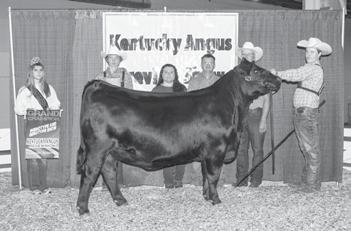
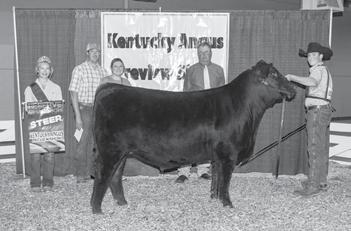






Phenotype Genotype Show was judged by Mr. Joe Myers from Kentucky. KY Junior Angus Preview Show was judged by Lake Elliott from Tennessee. 1. Grand Champion PGS, PHF Georgina 399, exhibited by Austin Petow 2. Reserve Grand Champion PGS, WF4 Liberty Belle Comm 3903 exhibited by Noah Adams 3. Grand Champion Steer, WF4 24 Karat 3217, exhibited by Owen Adams 4. Reserve Grand Champion Steer, Johnson Jack 330, exhibited by Seth Chunglo 5. Grand Champion Cow/Calf, McCauley Will J14 with bull calf at side McCauley Kingsman 1L2, exhibited by Adam McCauley 6. Reserve Grand Champion Cow/Calf, SWA Georgina 2104 with a heifer calf at side SWA Georgina 304, exhibited by McKenna Jackson 7. Grand Champion Bred and Owned Bull, SAF Slayer 3099 exhibited by Bryanna Smith 8. Reserve Grand Champion Bred and Owned Bull, SWA Doc Holliday 302 exhibited by Nicholas Jackson 9. Grand Champion Bred and Owned Heifer, SAF Lucy Pride 2103 exhibited by Bryanna Smith 10. Reserve Grand Champion Bred and Owned Heifer, McCauley Stormy L1 exhibited by Adam McCauley 11. Grand Champion Owned Heifer, Colburn Saras Dream 3755 exhibited by Jake Marksbury 12. Reserve Grand Champion Owned Heifer, PHF Georgina 396 exhibited by Kat Branscum • Grand Champion Senior Showman: Bryanna Smith • Reserve Grand Champion Senior Showman: Austin Petow • Grand Champion Intermediate Showman: Danielle Taylor • Reserve Grand Champion Intermediate Showman: Emily Jeffries • Grand Champion JR Showman:Braxton Brooks • Reserve Grand Champion JR Showman: Ellee Marksbury • PeeWee Showman: Sawyer Gray and Elijah Tolbert
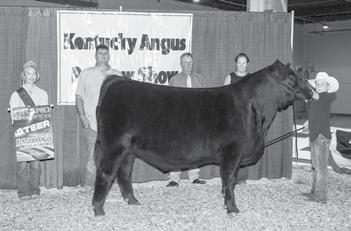
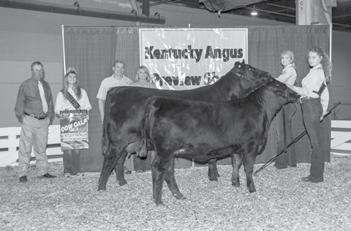

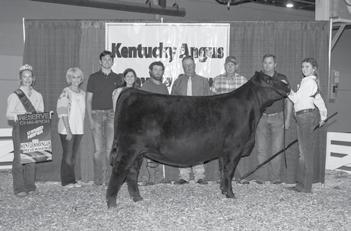

NEWS
KENTUCKY ANGUS ASSOCIATION
1 2 3 4 5 6 7 8 9 10 11 12 July • Cow Country • 41
KENTUCKY GELBVIEH ASSOCIATION
AA LAND & CATTLE
KENTUCKY GELBVIEH
Joe Piles, President............................................................................................................................(502) 507-3845
Registered Gelbvieh & Balancers
LARRY CLARK & SONS LLC
Johnnie Moore, Vice President...........................................................................................................(270)
Registered Gelbvieh Cattle
Cynthiana, KY
Pat Tilghman, Secretary/Treasurer.......................................................................................................(270)
Luke Arthur (859) 298-8323 luke.arthur93@gmail.com
BAR IV LIVESTOCK
Bulls • Show Prospects • Embryos Bulls sell with GE EPD’s • Show Prospects
BAR IV LIVESTOCK
106 Clark Houk Road • Greensburg, KY 42743
Larry Clark, Owner & Operator (270) 299-5167 • (270) 405-6848
Lpclarkandsons@msn.com
Barry, Beth & Ben Racke • Brad Racke • 7416 Tippenhauer Rd. • Cold Spring, KY 41076 Phone (859) 635-3832 • Barry cell (859) 991-1992 • Brad cell (859) 393-3677 • Ben cell (859) 393-3730 Fax (859) 635-3832 • bar4@twc.com
Barry, Beth & Ben Racke • Brad Racke 7416 Tippenhauer Rd. • Cold Spring, KY 41076
Phone (859) 635-3832 • Barry cell (859) 991-1992
BRAY’S GELBVIEH CATTLE
Brad cell (859) 393-3677 • Ben cell (859) 393-3730 Fax (859) 635-3832 • bar4@twc.com
Niles & Betty K Bray • 1568 Bray Ridge Road Bedford, KY 40006 • (502) 255-3584

CLIFFORD FARMS
3459 KY HWY 1284E
Cynthiana, KY 41031 Since 1937 (859) 234-6956
BRIAN W. DYER, DVM
BEE LICK GELBVIEHS
CD FARMS
Eddie Reynolds
277 Old Bee Lick Rd. Crab Orchard, KY 40419 606-379-2281(H) 606-305-1972(C)
Clayton & Debbie Cash 1214 Ottawa School Road • Brodhead, KY 40409 (606)-308-3247 • (606)-758-8994
Bulls & Females for sale
Owner/Manager
GELBVIEH/BALANCERS
2050 Glasgow Road Burkesville, KY 42717
Gelbvieh-Balancer Bulls & Heifers For Sale by Private Treaty
Brian, Lauren, Kristen Barry, Emily & Julia (270) 864-5909
BRIAN W. DYER, DVM
GELBVIEH/BALANCERS

Owner/Manager
2050 Glasgow Road • Burkesville, KY 42717
Brian, Lauren, Kristen Barry, Emily & Julia
MURLEY FARMS
REGISTERED GELBVIEH & BALANCER CATTLE
CD FARMS
Specializing in Red Genetics
Clayton & Debbie Cash 1214 Ottawa School Road Brodhead, KY 40409 (606)-308-3247 • (606)-758-8994
Jonathon & Breanna Murley • (270) 427-7727
PADON FARMS
Gelbvieh-Balancer Bulls & Heifers For Sale by Private Treaty
GELBVIEH BULLS & FEMALES FOR SALE 1012 Shelby Road • Salem, KY 24078 Thad Padon (270) 836-5518
PLEASANT MEADOWS FARM
UPCOMING EVENTS
Gary & Pat Tilghman • Carrie & Daryl Derossett Family 690 Lick Branch Road Glasgow, KY 42141 270.646.7024 • pleasantmeadowsfarm@hotmail.
Saturday May 15
Kentucky Junior Gelbvieh Show & Learning Clinic
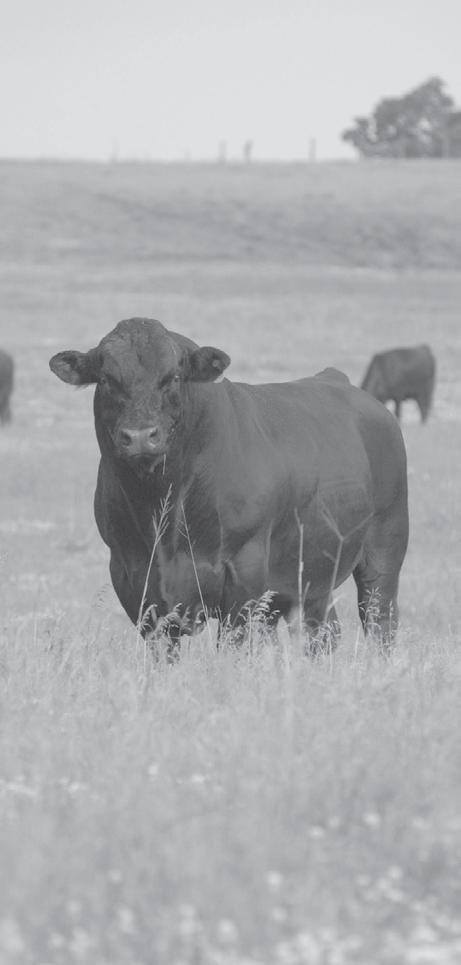
R&D OWEN FARMS
McIntosh Brothers Farm • 3348 Frankfort Road • Georgetown 10AM Learning Clinic • 12:30PM Show
Call William McIntosh for more information. (502) 867-3132
AA LAND & CATTLE
GELBVIEH & BALANCERS PO Box 781 • Eddyville, KY 42038 (270) 601-6830 • rdowenfarms.com • sales@rdowenfarms.com
Friday May 28 - May 30
Registered Gelbvieh & Balancers Cynthiana, KY
AGJA Eastern Regional Junior Show “Run for the Roses”
LARRY CLARK & SONS LLC
DONE WRIGHT CATTLE FARMS
Burley Fields Livestock Center • 709 Oil Fields Road • Horse Cave
Luke Arthur (859) 298-8323
luke.arthur93@gmail.com
Bulls • Show Prospects • Embryos Bulls sell with GE EPD’s • Show Prospects
Registered Gelbvieh Cattle 106 Clark Houk Road • Greensburg, KY 42743
Casey Wright, Owner 2665 Poplar Corner Road • Lebanon, Kentucky 40033 270-692-7496 * donewrightcattle@hotmail.com
Call Carrie Derossett for more information. (270) 404-0828 Entry and room information available at www.gelbvieh.org (Juniors/Regional Shows/AGJA Eastern Regional)
BAR IV LIVESTOCK
S&S GELBVIEH
Barry, Beth & Ben Racke • Brad Racke 7416 Tippenhauer Rd. • Cold Spring, KY 41076 Phone (859) 635-3832 • Barry cell (859) 991-1992 Brad cell (859) 393-3677
Larry Clark, Owner & Operator (270) 299-5167 • (270) 405-6848 Lpclarkandsons@msn.com
BREEDING RED & BLACK POLLED GELBVIEH SINCE 1982
David, Jerri & Jon David: 162 Hastings Ln • Fredonia, KY 42411 (270) 556-4259 Arthur & Joyce Slaughter 19068 Marion Rd • Fredonia, KY 42411 (270)545-3455
Ben cell (859) 393-3730 Fax (859) 635-3832 • bar4@twc.com
FULL CIRCLE FARMS REGISTERED GELBVIEH CATTLE
Brad Burke: 989 Metcalfe Mill Rd, Ewing, KY 41039 (H) 606-267-5609 (C) 606-782-1367 gbb789@windstream.net
CALLING ALL GELBVIEH JUNIORS


Join the Facebook group of Kentucky Junior Gelbvieh Association for upcoming events and information.
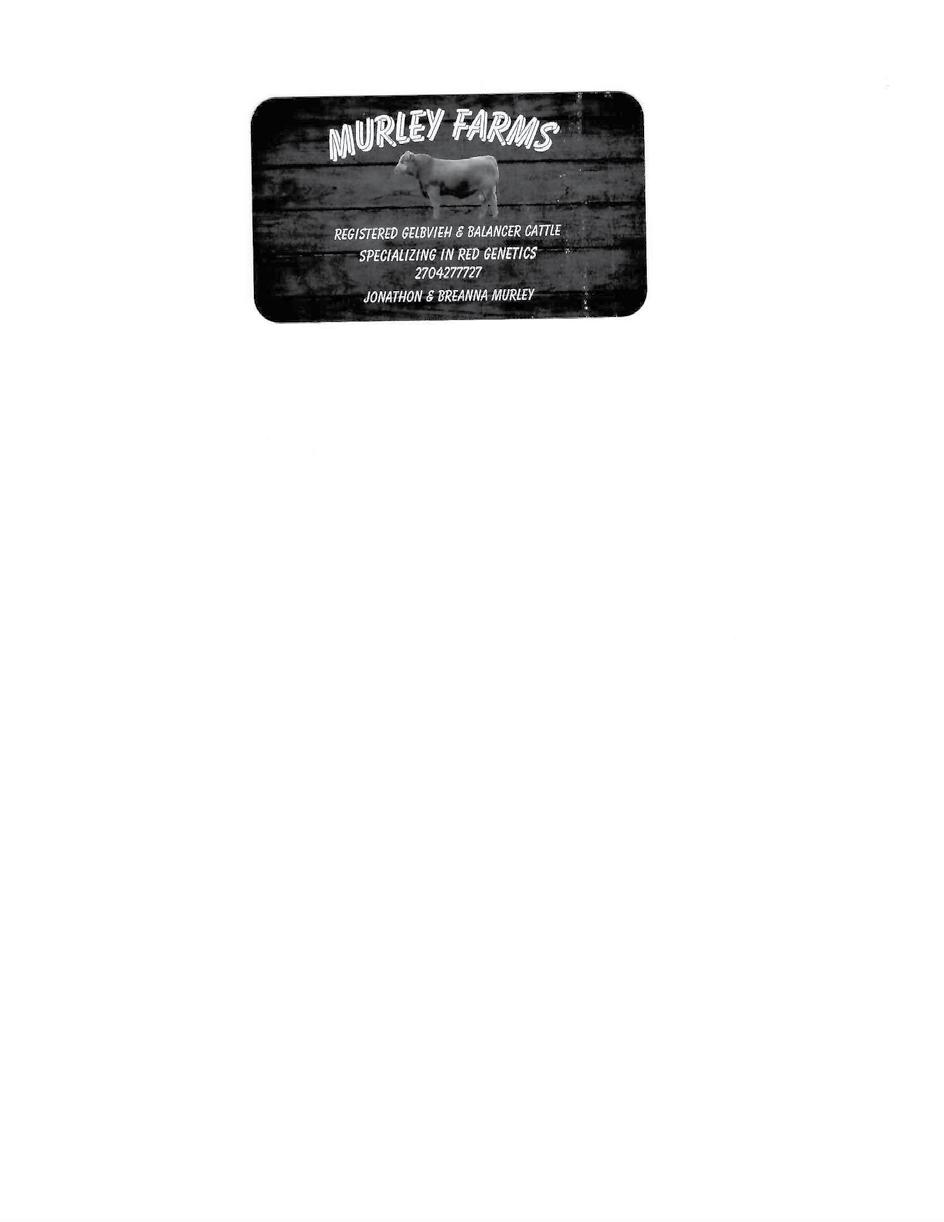
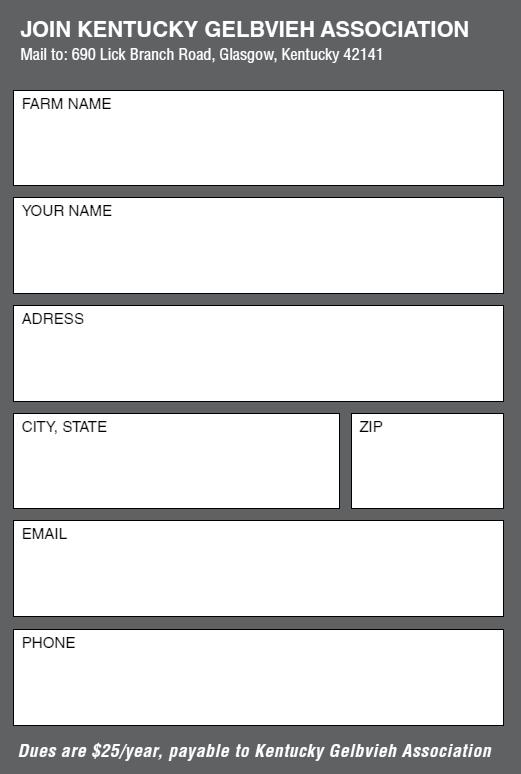
Cattle for sale at all times. Meeting modern industry demands:
670-7814
670-8449
Association
to advertise in this ad, please contact KENTUCKY GELBVIEH ASSOCIATION
or
CLIFFORD FARMS 3459 KY HWY 1284E Cynthiana, KY 41031 Since
234-6956 BEE LICK GELBVIEHS Eddie Reynolds 277 Old Bee Lick Rd. Crab Orchard, KY 40419 606-379-2281(H) 606-305-1972(C) Bulls & Females for sale BRIAN W. DYER, DVM Owner/Manager GELBVIEH/BALANCERS 2050 Glasgow Road Burkesville, KY 42717 Brian, Lauren, Kristen Barry, Emily & Julia (270) 864-5909 FULL CIRCLE FARMS Registered Gelbvieh Cattle Brad Burke 989 Metcalf Mill Road • Ewing KY 41039 KENTUCKY GELBVIEH ASSOCIATION Cattle for sale at all times. David Slaughter, President.......................(270) 556-4259 Joe Piles, Vice President...........................(502) 507-3845 PatTilghman, Secretary/Treasurer..............(270) 670-8449 Joe Piles, President............................................................................................................................(502) 507-3845 Johnnie Moore, Vice President...........................................................................................................(270) 670-7814 Pat Tilghman, Secretary/Treasurer.......................................................................................................(270) 670-8449 ASHWOOD SPRING GENETICS Luke & Lindsay Arthur Cynthiana, KY 859-298-8323
W. DYER, DVM Owner/Manager GELBVIEH/BALANCERS 2050 Glasgow Road Burkesville, KY 42717 Brian, Lauren, Kristen Barry, Emily & Julia (270) 864-5909 BAR IV LIVESTOCK Barry, Beth & Ben Racke • Brad Racke 7416 Tippenhauer Rd. • Cold Spring, KY 41076 Phone
• Barry cell
Brad
•
Fax
•
FULL CIRCLE FARMS Registered Gelbvieh Cattle Brad Burke 989
Road •
KY 41039
•
gbb789@windstream.net BEE LICK GELBVIEHS Eddie Reynolds 277 Old Bee Lick Rd. RICH HILL GELBVIEH Frank McAninch 1341 Iven Godby Road 42 • Cow Country • July
•
1937 (859)
BRIAN
(859) 635-3832
(859) 991-1992
cell (859) 393-3677
Ben cell (859) 393-3730
(859) 635-3832
bar4@twc.com
Metcalf Mill
Ewing
(H) 606-267-5609
(C) 606-782-1367
Kentucky Hereford Association
Kentucky Hereford Association
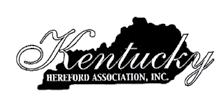
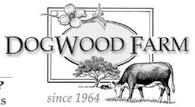
Toby & Debby Dulworth
Toby & Debby Dulworth 2492 S. Kirkman Road LaCenter, KY 42056 (270) 224-2993 dogwood@brtc.net
2492 S. Kirkman Road LaCenter, KY 42056 (270) 224-2993 dogwood@brtc.net
Herefords that thrive on forages. www.dogwoodherefords.com
Herefords that thrive on forages. www.dogwoodherefords.com

6077 Helena Road
JNHE 25th Anniversary The Grand Daddy of ‘Em All
Grand Island, Nebraska July 6th-12th, 2024
KJHA Advisors Matt & Melinda Watson 606-748-1600
WELLS FARM
WELLS FARM
Polled Herefords

KHA OFFICERS
KHA OFFICERS
439 Flatwoods Frozen Camp Rd, Corbin KY 40701
Polled Herefords 439 Flatwoods Frozen Camp Rd, Corbin KY 40701
Bobby & Brenda Wells (606) 523-0569 or (606) 344-0417 wells_farm@yahoo.com
Bobby & Brenda Wells (606) 523-0569 or (606) 344-0417 wells_farm@yahoo.com
Kevin, Angela, Kenlea & Kyler Murray (606) 528-1691 or (606) 682-8413
Kevin, Angela, Kenlea & Kyler Murray (606) 528-1691 or (606) 682-8413

6077 Helena Road Mayslick, KY 41055
Mayslick, KY 41055
MPH Farms
MPH Farms
Charlie Boyd II 606-584-5194
Charlie Boyd II 606-584-5194
Annual Bull Sale second Saturday in March Hereford and Angus Bulls
Annual Bull Sale second Saturday in March Hereford and Angus Bulls
Chambliss
Chambliss
Hereford Farms
Hereford Farms
Brad, Carla, Clay & Clint Chambliss 1101 Driftwood Lane Elizabethtown, KY 42701
Brad, Carla, Clay & Clint Chambliss 1101 Driftwood Lane
Elizabethtown, KY 42701
Home (270) 982-3905
Home (270) 982-3905
Cell (270) 668-7126 fax 270-735-9922
Cell (270) 668-7126 fax 270-735-9922
www.chamblissherefordfarms.com
www.chamblissherefordfarms.com

WCN Polled Herefords Since 1961
WCN Polled Herefords Since 1961
Bill Norris 2220 Celina Road
Bill Norris 2220 Celina Road
Burkesville, KY 42717
Burkesville, KY 42717
Phone (270) 433-7256
Phone (270) 433-7256
Cell (270) 433-1525
Cell (270) 433-1525
“Every calf needs a white face”
“Every calf needs a white face”

Shannon, Kerry, Emily, Will & Ellie Morgan 13095 Scottsville
NJB Limited
President: LW Beckley DVM 859-779-1419
NJB Limited

President: Chris Hopper 606-584-7842
Secretary/ Treasurer: Melinda Watson 859-625-8660
melindawatson8660@gmail.com
Secretary/ Treasurer: Melinda Watson 859-625-8660 melindawatson8660@gmail.com
Dale Stith 5239 Old Sardis Pike
Dale Stith 5239 Old Sardis Pike
Mays Lick, KY 41055
HEREFORDS
HEREFORDS
Codee Guffey • 1815 Grassy Springs Road
dalestith@yahoo.com (918) 760-1550
Mays Lick, KY 41055 dalestith@yahoo.com (918) 760-1550
Codee Guffey • 1815 Grassy Springs Road Versailles, Kentucky 40383 (502) 598-6355 rockridgeherefords@gmail.com www.rockridgeherefords.com
Versailles, Kentucky 40383 (502) 598-6355 rockridgeherefords@gmail.com www.rockridgeherefords.com
K3 CATTLE REGISTERED HEREFORDS

TK4 Herefords
Registered Polled Herefords PAUL L. HANCOCK 8559 KY 56 Owensboro, KY 42301 270-771-4194
Registered Polled Herefords PAUL L. HANCOCK 8559 KY 56 Owensboro, KY 42301 270-771-4194

K3 CATTLE REGISTERED HEREFORDS KYLE BUSH K3CATTLE@YAHOO.COM 859-588-4531 198 HICKS PIKE CYNTHIANA, KY 41031
KYLE BUSH K3CATTLE@YAHOO.COM 859-588-4531 198 HICKS PIKE CYNTHIANA, KY 41031
THOMAS FARM
THOMAS FARM
Jackson
Farms
Jackson Farms
Registered Polled Herefords PO Box 215 Cross Plains, TN 37049 615-478-4483
Registered Polled Herefords PO Box 215 Cross Plains, TN 37049 615-478-4483
billymjackson@aol.com
billymjackson@aol.com
“Farming the Same Land Since 1834”
“Farming the Same Land Since 1834”
WOLF FARM
WOLF FARM
Registered Polled Herefords Bulls & Females for sale
Registered Polled Herefords Bulls & Females for sale
Tim & Peggy Wolf 12939 Peach Grove Road Alexandria, KY 41001 Home: 859-635-0899 Cell: 859-991-3484
Tim & Peggy Wolf 12939 Peach Grove Road Alexandria, KY 41001 Home: 859-635-0899
Cell: 859-991-3484

Eric & Ronnie Thomas 2396 Union City Rd. Richmond, KY 40475 (859) 623-5734
Eric & Ronnie Thomas 2396 Union City Rd. Richmond, KY 40475 (859) 623-5734
Eric’s Cell (859) 314-8256
Eric’s Cell (859) 314-8256
“Cattle for sale at all times”
“Cattle for sale at all times”

BECKLEY HEREFORDS
BECKLEY HEREFORDS
L. Wayne Beckley • 1420 Fitchburg Rd. Ravenna, KY 40472 • 606-723-3021 Cell: 859-779-0962
L. Wayne Beckley • 1420 Fitchburg Rd. Ravenna, KY 40472 • 606-723-3021 Cell: 859-779-0962
L.W. Beckley D.V.M 284 Pyrse Lane • Irvine, KY 40336 Cell: 859-779-1419 • Clinic: 606-726-0000 www.beckleyherefords.com
L.W. Beckley D.V.M 284 Pyrse Lane • Irvine, KY 40336 Cell: 859-779-1419 • Clinic: 606-726-0000 www.beckleyherefords.com

Polled Hereford and Gelbvieh Cattle 3459 KY Hwy. 1284 E. Cythiana, KY 41031 (859) 234-6956
Polled Hereford and Gelbvieh Cattle 3459 KY Hwy. 1284 E. Cythiana, KY 41031 (859) 234-6956
Ben, Jane, Shelby and Lincoln
Ben, Jane, Shelby and Lincoln
Tony & Kathy Staples 992 Knotts Road
Tony & Kathy Staples 992 Knotts Road Brandenburg, KY 40108 (270) 422-4220 tstaples@bbtel.com
Brandenburg, KY 40108 (270) 422-4220 tstaples@bbtel.com
Windy Hills Farm
Windy Hills Farm
Jackie D. Perkins II 367 Mt. Pisgah Rd. Bremen, KY 42325 (270) 543-3586
Jackie D. Perkins II 367 Mt. Pisgah Rd. Bremen, KY 42325 (270) 543-3586
Breeding to produce good cows since 1981
Breeding to produce good cows since 1981

PILE STOCK FARM
PILE STOCK FARM
Registered Polled Herefords HANSELL PILE, JR. 12045 St. John Rd. Cecilia, KY 42724
270-735-5192
270-862-4462 12 miles West of Elizabethtown
Registered Polled Herefords HANSELL PILE, JR. 12045 St. John Rd. Cecilia, KY 42724 270-735-5192 270-862-4462 12 miles West of Elizabethtown

TUCKER STOCK FARMS
Tucker Stock Farms
Tucker Stock Farms
“Breeding Polled Herefords for over 58 Years” Breeding cattle for sale at all times. 1999 Walnut Hill Rd. Lexington, KY 40515 (859) 271-9086 cell (859)533-3790
“Breeding Polled Herefords for over 58 Years” Breeding cattle for sale at all times. 1999 Walnut Hill Rd. Lexington, KY 40515 (859) 271-9086 cell (859)533-3790

“Registered Angus and Polled Herefords”
“Registered Angus and Polled Herefords”
John Tucker II 1790 Hidden Valley Lane Hudson, KY 40145 270-617-0301
John Tucker II 1790 Hidden Valley Lane Hudson, KY 40145 270-617-0301
“Bulls always for Sale”
“Bulls always for Sale”
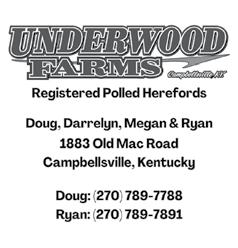
TK4 Herefords
Shannon, Kerry, Emily, Will & Ellie Morgan 13095 Scottsville Rd, Alvaton, Kentucky 42122 www.morganandmorganpolledherefords.com Shannon: (270) 320-2389
The Lowell Atwood Family 133 Edgewood Drive • Stanford, KY (606) 365-2520 home/fax (606) 669-1455 cell Victor- influenced cattle bred for performance on grass. “Black cows need a good Hereford Bull” Danny Miller jmspolledherefords.com 270-465-6984 270-566-2694 WATSON LAND & CATTLE Matt, Melinda, Harlee, & Wyatt Watson 6196 Mount Sterling Rd Flemingsburg, Kentucky melindawatson8660@gmail.com - 606-748-1600 Melinda - 859-625-8660 CATTLE FOR SALE AT ALL TIMES TUCKER STOCK FARMS “Registered Angus and Polled Herefords” John A. Tucker II 1790 Hidden Valley Lane Hudson, KY 40145 (270) 257-8548 Office (270) 257-8167 18-month-old Angus & Polled Hereford Bulls For T S F 4850 Caldwell Ridge Rd. Knifley, KY 42753 270-465-6984 Fertility Milking Ability Calving Ease Disposition Multi-Trait Selection LINEBRED VICTOR DOMINO CATTLE
Peyton’s Well Polled Herefords
Kentucky Beef Expo Schedule
Hereford Show - 1pm
Hereford Sale
1pm
Friday March 1st -
Saturday March 2nd -
-
Sunday March 3rd - Open Junior Show - 8am
Rd, Alvaton, Kentucky 42122 www.morganandmorganpolledherefords.com Shannon:
320-2389
Well Polled Herefords The Lowell Atwood Family 133 Edgewood Drive • Stanford, KY (606) 365-2520 home/fax (606) 669-1455 cell Victor- influenced cattle bred for performance on grass. “Black cows need a good Hereford Bull” Danny Miller jmspolledherefords.com 270-465-6984 270-566-2694 WATSON LAND & CATTLE Matt, Melinda, Harlee, & Wyatt Watson 6196 Mount Sterling Rd Flemingsburg, Kentucky melindawatson8660@gmail.com Matt - 606-748-1600 Melinda - 859-625-8660 CATTLE FOR SALE AT ALL TIMES
(270)
Peyton’s
“Registered Angus and Polled Herefords” John A. Tucker II 1790 Hidden Valley Lane Hudson, KY 40145 (270) 257-8548 Office (270) 257-8167 18-month-old Angus & Polled Hereford Bulls For T S F 4850 Caldwell Ridge Rd. Knifley, KY 42753 270-465-6984 Fertility Milking Ability Calving Ease Disposition Multi-Trait Selection LINEBRED VICTOR DOMINO CATTLE July • Cow Country • 43
CALENDAR OF EVENTS
DATE EVENT LOCATION AD
JUN 24 KCA Hall of Fame Applications Due
JUL 8-14 Lexington Burger Week Lexington, KY
JUL 14-21 Louisville Burger Week Louisville, KY
JUL 19-20 Kentucky National Show and Sale Bowling Green, KY 13
JUL 24 Campbell Co Backroads Farm Tour Campbell County, KY
AUG 24 CPH-45 Sale Guthrie, KY 21
AUG 24 CPH-45 Sale Owensboro, KY 21
AUG 15-25 Kentucky State Fair Louisville, KY
SEP 24 CPC Fall Field Day Fountain Run, KY 10
SEP 25-26 Intermediate Grazing School Versailles, KY
SEP 24 The Foundation Sale X Bowling Green, KY 45
OCT 4-6 KJCA Fall Classic Bowling Green, KY
OCT 15-17 Heart of America Grazing Conference Elizabethtown, KY
OCT 25-26 Yon Family Farms Maternal Roots Fall Female & Bull Sale Ridge Spring, SC
DEC 24 CPH-45 Sale Owensboro, KY 21
DEC 24 Knoll Crest Farm Total Performance Bull Sale Red House, VA
DEC 24 CPH-45 Sale Guthrie, KY 21
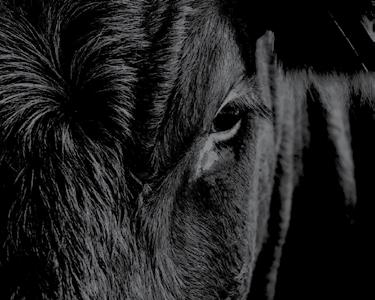

Our fresh, natural product is sourced from Kentucky farm families who share a commitment to animal care and the environment. From farm to table, we support Kentucky cattlemen and local businesses to provide the Bluegrass with a delicious ground beef product.
DIAMOND J SALERS
Donald Johnson • 11660 N. Hwy 1247 • Eubank, KY 42564 606-379-1558
DIAMOND J SALERS
WILLIS FARMS
Donald Johnson • 11660 N. Hwy 1247 • Eubank, KY 42564 606-305-8747
Danny Willis • 964 Johnson Rd • Frankfort, KY 40601 • 502-803-5011 drwc21@aol.com • Purebred + Optimizer Breeding bulls & Heifers for sale.
DEL-SU FARM
WILLIS FARMS
Howard & Sue Edwards • 420 Rose Rd • Somerset, KY 42501 606-679-1675 • Jeriah Privett • 606-416-1154
Danny Willis • 964 Johnson Rd • Frankfort, KY 40601 502-803-5011 • drwc21@aol.com
KNOB LICK FARM - BULLS & HEIFERS FOR SALE
Larry Cox • Tina Cox-Lynch • Amanda Cox Gibson • 1315 Knob Lick Road • Irvine, KY 40336 • 606-723-3077 • 606-975-1716
THE
SALERS
BALANCED BREED
kentuckycattlemensbeef.com
44 • Cow Country • July
REGISTERED RED ANGUS BULLS FOR SALE
FOUR WINDS FARM N ew Castle, Kentucky (502) 296-1044
PERFORMANCE TESTED PUREBRED ANGUS BULLS FOR SALE
Call 270-202-7186 for more info or check out www.oakhollowangus.com for current availability.
POLLED HERFORD BULLS FOR SALE
19–20-month-old Polled Hereford bulls. Good selection. Low birthweight, medium frame. Free Delivery Available. JMS Polled Herefords, Knifley, KY Danny 270-566-2694 Trent 270-566-2000
THE FOUNDATION SALE X
Sat., Sept. 21 2024. 1 PM CT United Producers, Bowling Green, KY
Selling Fullblood & Purebred Limousin For info, call ACH Holdings LLC Stephen Haynes 270-799-8685
REGISTERED BLACK SIMMENTAL BULLS
Many blaze faced. Excellent EPD’s. Semen Tested. Delivery Available. Maximize your profit with proven performance. All bulls qualify for new CAIP cost-share. Adam Wheatley 502349-2665
BREEDING AGE HEREFORD BULLS FOR SALE AT ALL TIMES
Over 60 years of Line 1 Hereford Genetics. Groups of open and bred heifers available for sale at all times. Chambliss Hereford Farms. 270-668-7126
HAY FOR SALE
Between 600 and 1,000, 4’x6’ NET ROLLS
Hay is a mix of fescue, Bermuda, a good amount of white clover and crabgrass; fertilizer and herbicides sprayed to get rid of weeds Located in Flintville, TN
Joe Lampley, 256-683-4990
RED ANGUS, SIMANGUS, CHAROLAIS, ANGUS FOR SALE
Red Hill Farms, Lafayette, TN, 615-666-3098
Bart, Sarah and Ty Jones
Gordon and Susan Jones, 270-991-2663
Visit us online - www.RedHillFarms.net
Contact us for cattle and semen availability. Annual Production Sales:
More Than a Bull Sale – 3rd Saturday in March Maternal Monday – 3rd Monday in May
Bulls & Females of Fall Sale – Last Saturday in October
JULY DEALS FROM REDBARN
JOHN DEERE-7000 -6 row planter
JOHN DEERE 5085 E - open station- loader ready JD 567 round baler-string-$19,995 NH 315 - square baler $7500 Class 375wrapper and baler -$34,500 JD 3975 silage chopper ESCH HAY TEDDERS-18-32 ft units Cloverdale 420-500-650 Mixers in STOCK Bearclaw construction trailer- 16-40’ton
New Holland 195- double beater spreader
$18,500 New Holland Bale Wagon- H9870 $142,500 JD 566 round baler- twine only
$9500 John Deere 6300-2wd-Ldr- 16 speed
$35,000 Artex SB 200-800 Spreaders- HS 430 Spreader- $21,500 MEYER F510- mixer in stock $60,000 Vermeer 555 - XL in stocktwine-$10,500 Silage time-10 pull type choppers in stock Silage Blowers- IN STOCK Silage Wagons-16-20 ft 18 IN STOCK-Lancaster Ky
Meyer- miller pro- H S- all prices and ranges MEYER- 18 ft- dump carts - 2 super units!
Finance options available Call Charlie today, 859-608-9745
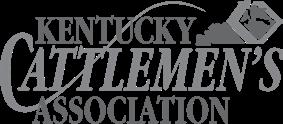
July • Cow Country • 45 CLASSIFIEDS
*
*
FREE DELIVERY
Contact
AD INDEX Allison Charolais 8 Baumalight 48 Blue Grass Stockyards 9 Corteva Agrisciences 11 CPC Animal Health 7 CPC Field Day 10 Hampton Premium Meats 47 Innovacyn 4 Kentucky Angus Association 40 Kentucky Cattlemen's Ground Beef 44 Kentucky Division of Water 19 Kentucky Gelbvieh Association 42 Kentucky Hereford Association 43 Kentucky National Sale 13 Kentucky Salers Association 44 Kentucky Santa Gertrudis Assn 38 Kentucky Simmental Association 39 Kuhn North America 5 My Team Cattle & Crop Insurance 9 Oak Hollow 3 Pogue Chevrolet 5 Red Barn and Associates 8 Santa Gertrudis Breeders Int 13 Zoetis 2
ADVERTISE IN OUR CLASSIFIEDS $15 FOR FIVE LINES OR GET A BOX THIS SIZE FOR $105 CALL KATIE PRATT (859) 278-0899 MULTI-ISSUE DISCOUNTS AVAILABLE

Keep Cool in the Shade
Jeff Lehmkuhler PhD, PAS, Extension Professor, University of Kentucky
As the summer weather hits full stride, take some time to focus on factors that impact animal performance during these months. Stocker calf performance reflects changes in the environment, plane of nutrition and overall health of calves. Be mindful of the how summer weather can impact these three overarching factors and consider what you might alter or maintain to minimize the impact of these elements.
Heat stress is the first environmental factor that will impact animal performance during the summer. The effect of heat stress is exacerbated by the alkaloids produced by the wild endophyte in Kentucky 31 tall fescue. Animals compensate during heat stress with increased respiration rate, increased skin vaporization (sweating), increased peripheral blood flow, decreased appetite to reduce metabolic heat production, and more time seeking relief by standing in the shade, congregating in water or grouped up in areas where urine and feces create a wallow. Increased respiration rate leads to greater energy expended for contraction and relaxation of the diaphragm. This doesn’t seem like it would be a big loss but sit there and double your breaths per minute for five minutes and see how you feel. Now consider doubling your respiration for several hours a day and the impact this would have on energy expended. Previous research has shown that cattle at thermoneutral conditions had respiration rates of about 23 breaths per minute. Under heat stress, this increased to 54 breaths per minute. This increased respiration rate is a key response to heat stress as well as increasing blood flow to periphery.
Compensation of heat stress can also occur through increased sweating or evaporative heat loss as periphery blood flow increases.
Skin evaporative energy loss was observed to be 50% greater under heat stress than thermoneutral. However, when exposed to wild-type endophyte, skin vaporization was not increased due to a lack of skin temperature increase, which may be attributed to vasoconstriction.
Accumulated heat load by animals can be dissipated later into the night when ambient temperatures decline. However, during periods of high humidity and lack of nighttime temperatures falling, animals do not have significant reductions in core body temperature before the next day begins. Successive days of heat stress and minimal dissipation of accumulated heat load leads to severe health concerns for cattle. Add into the mix, the alkaloids from the wild endophyte in tall fescue leading to vasoconstriction reducing blood flow to the skin surface during these night hours, limiting heat dissipation from sweating. All these factors combine to increase animal maintenance requirements by 7-25%. If maintenance energy requirements represent 65% of normal daily intake, a 15% increase in maintenance requirements as a result of heat stress would reduce gains significantly. Providing shade is the first management strategy to help mitigate heat stress during the summer. Shade helps to reduce heat loading from solar radiation. Additionally, ground surface temperatures under shade have been shown to be greatly reduced compared to unshaded areas. Shade can be natural, such as wooded areas, or man-made. Cattle will stand more during heat stress to allow more convection heat loss as air moves around the body. Shade should ideally provide sufficient room for cattle to stand in the shade without being crowded.
Often, the question is how much shade should be provided. Consider the length from tip of nose to tail
and width across the ribs of a mature cow. These measurements may be near 7 feet x 3 feet or 21 square feet and these measurements will vary. Spacing between animals is important so the actual shade provided will be greater than the size of the animal. Actual allocated area under shade of 30-40 square feet per cow may be necessary. The University of Nebraska recommends 20-25 square feet per animal for voluntary shade use in feed yards and 25-30 square feet for high-risk feeders on arrival. For man-made structures, ensure there is sufficient distance between the back of the animal while standing and the bottom of the shade structure to facilitate air movement through the structure. When possible, having portable shade structures will minimize wallows, which can lead to high humidity under the shade from excessive urine and feces deposition. Additional information on shade structures can be found at https:// www2.ca.uky.edu/agcomm/pubs/ aen/aen99/aen99.pdf .
Consider developing shade areas during periods of higher temperatures and humidity to maintain the performance of grazing cattle if wooded areas are not readily available. Temporary electric fencing can be helpful in allocating different areas of wooded areas to minimize soil disturbance under trees and preventing development of wallows. Shade placed on ridges that have greater wind speeds will aid in moving air through the structures and cooling cattle. Ensure cattle have access to fresh, clean water as losses from sweating and increased respiration rates increase water requirements. Consider utilizing CAIP funds for shade or tree plantings for development of natural shade areas. Contact your county extension office for additional information.
46 • Cow Country • July
Spring-Calving Cow Herd
• Consider removing bulls from the cow herd by the end of the month and keep them away from the cows. A short calving season can concentrate labor; group calves by age, so that it is easier to find a convenient time to vaccinate, castrate, dehorn, etc.; and provide a more uniform group of calves at market time.
• Mid-July is a good time to deworm cattle. Use a product that is effective against inhibited ostertagia. Re-implant calves which were implanted at birth if the type of implant and amount of time indicate. Vaccinate calves that haven’t been vaccinated for blackleg. Spraying or using a pour-on for flies while cattle are gathered can supplement other fly control methods. Remember to work cattle early in the morning when it is cool and handle them gently to minimize stress.
• Watch for pinkeye and treat if necessary. Minimize problems by clipping pastures, controlling face flies and providing shade. Monitor the bulls’ activity and physical condition as the breeding season winds down.
• Fescue pastures tend to go dormant in July and August, so look for alternatives like warm-season grasses during this time. Try to keep the young calves gaining weight. Go to pastures which have been cut for hay to have higher quality regrowth when it is available.
• Consider cutting warm-season grass pastures for hay if reserves have not been restored yet.
• Heat stress can lead to low conception rates, low libido in bulls and embryonic loss (abortion) between days six and 45 of pregnancy. Keep a close eye on your herd. Plan to diagnose your herd for pregnancy early this fall to identify open cows for future planning. Supplementation with red clover helps alleviate some of the issues with heat stress due to fescue toxicosis.
Fall-Calving Herd
• Deworm calves in mid-July with a product that is effective against inhibited ostertagia.
• Fall-calving cows should be dry and pregnant now. Their nutrient needs are minimal, and they can be maintained on poor pasture to avoid over fattening. Keep a good, free-choice mineral mix available at all times. You can use a lower phosphorus mineral supplement now, if you want to save a little money. These cows are regaining body condition after a long winter-feeding period.
• Get ready for fall calving and plan to have good pasture available at calving and through the breeding season.
Stockers
• Sell heavier grazing cattle before rate of gain decreases or they get into a heavyweight category. This will also relieve grazing pressure as pasture growth diminishes. They can be replaced with lightweight calves after pastures recover.
• Lighter cattle which are kept on pasture need to be rotated to grass-legume or warm-season grass pastures to maintain a desirable level of performance. Re-implant these calves and deworm with a product that is effective against inhibited ostertagia.
General
• Check pastures for downed wild cherry trees after storms. Wilted wild cherry leaves are toxic to cattle.
• Be sure that clean water is always available, especially in hot weather. Make routine checks of the water supply. Cattle need 13 to 20 gallons of clean water in hot weather. Cattle should have access to shade.
• Maintain a weed control program in permanent pastures and continue to “spot-spray” thistle, honey locust, etc.
• Have forage analyses conducted on spring-cut hay and have large, round bales covered. Begin planning the winter feeding program now. Most of the hay was cut late due to a wet spring.
• Start soil testing pastures to determine fertilization needs for this fall.
• July is typically dry in Kentucky. Begin planning now for reduced rainfall and forage growth. If the weather dries up, you may need to begin feeding hay/supplement in August-October to allow for fall stockpiling of fescue.




Hampton Premium Meats was founded in 1975.
100% USDA inspected slaughter and processing of Beef, goat, sheep and swine.
Excellent vacuum packaging and labeling for resale. Smoke house available for any processed animals. Third party BRC certified.
Halal harvest on Mondays and Thursdays. PAACO Animal Welfare audited for beef cattle.
Trucking available to pick animals up in Central Kentucky area one day each month to get animals to slaughter. Call for scheduling as we will have to coordinate a load.
Immediate processing dates available.
Wholesale accounts welcome. (270) 847-0634 Chris (call or text) (270) 885-8474 Office orders@hamptonpremiummeats.com
July • Cow Country • 47
TIMELY TIPS FOR JULY


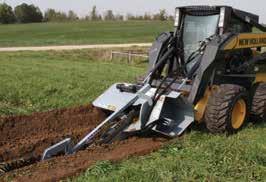


MFG OF MINI SKID STEERS AND A VARIETY OF ATTACHMENTS INCLUDING BRUSH MULCHERS | ROTARY BRUSH CUTTERS | STUMP GRINDERS | PTO GENERATORS TREE SPADES | TREE SAWS & SHEARS | BOOM MOWERS | TREE PULLERS | FELLER BUNCHERS | TRENCHERS AUGER DRIVES | EXCAVATOR ADAPTERS | SCREW SPLITTERS | PTO POWER PACKS | FLAIL MOWERS sales@baumalight.com | BAUMALIGHT.COM Terry Bailey 573-326-0484 | tbailey@omega1w.net

















































































 Isaac
Isaac

 Bradon Burks Director of Education
Bradon Burks Director of Education











































 President: Henry B. Smith
President: Anne Patton Schubert
President: Henry B. Smith
President: Anne Patton Schubert











































